Online Resources
Papers archive
Online Resources
Papers archive
M. Garai, P. Guidorzi, “On the declaration of the measurement uncertainty of airborne sound insulation of noise barriers” (invited paper),
Proc. Inter-Noise 2013, Innsbruck, Austria, ISSN 0736-2935, Paper 94, 1-10 (2013)
Proc. Inter-Noise 2013, Innsbruck, Austria, ISSN 0736-2935, Paper 94, 1-10 (2013)
- ABSTRACT
- The declaration of the results of a measurement cannot be considered complete if not accompanied by a clear and realistic declaration of the measurement uncertainty. Airborne sound insulation of noise barriers makes no exception. It is measured in the laboratory under a diffuse sound field (EN 1793-2) and in situ (EN 1793-6) in a direct sound field. The uncertainty in laboratory conditions can be assessed referring to ISO DIS 12999-1; the uncertainty in field conditions can be assessed referring to the outcomes of the QUIESST project. This paper shows how these findings should be used to derive the so called expanded uncertainty of the results, both in one-third octave bands and for the single-number ratings. An approach to presenting and interpreting the results consistent with the ISO GUM is given. The differences from the previous practice are highlighted, in particular when the classification into categories of the barrier under test for the purpose of CE marking (EN 14388) is concerned. Some ideas for the future updates of the relevant standards are proposed. For the first time, it is shown how to deal with measurement uncertainty of airborne sound insulation of noise barriers.
- CONCLUSIONS
- The declaration of the measurement uncertainty and the related confidence level is mandatory in all European test standards. This has a deep effect on the rough classification of noise barriers in categories for airborne sound insulation based only on the value of the single-number rating. Estimates of the standard deviation of reproducibility do exist, both for the diffuse field method (EN 1793-2) and the direct sound field method (EN 1793-6) and must be used. The 95% credibility interval should be assessed before rounding the single-number rating. The simple acceptance rule in use until now carries a high risk of incorrect decision and thus it should be replaced by better rules. In the light of the goal of the decision, i.e. the declaration of a performance level for CE marking, it seems reasonable to adopt the combination of the stringent acceptance and relaxed rejection rules. This new decision procedure gives results different from those obtained ignoring the uncertainty. Moreover the procedure appears complex and requires some knowledge of statistics. A simpler alternative could be the elimination of the categories: the single-number rating will be directly the performance level.

P. Guidorzi, M. Garai, “Impulse responses measured with MLS or Swept-sine signals: a comparison between the two methods applied to noise barriers measurements”,
Proc. AES Convention, Roma, Italy,
ISBN 978-0-937803-91-2, Paper ID 8914, 1-10 (2013)
Proc. AES Convention, Roma, Italy,
ISBN 978-0-937803-91-2, Paper ID 8914, 1-10 (2013)
- ABSTRACT
- A sound source and a microphone grid are used for measuring a set of impulse responses with the purpose of estimating the in-situ acoustical characteristics of noise barriers (sound reflection and airborne sound insulation) following the CEN/TS 1793-5 European standard guidelines as improved by the European project QUIESST. The impulse responses are measured using MLS (Maximum Length Sequence) and Swept-sine signals. The acoustical characteristics of the noise barrier, obtained using the two signals, are generally equivalent, but in some critical measurement conditions a discrepancy can be found. Differences and advantages between measurements, obtained by means of MLS or Swept-sine signals, are analyzed and discussed in this paper.
- CONCLUSIONS
- Reflection Index and Sound Insulation Index test measurements performed on a real scale noise barrier showed advantages in the use of Swept-sine for these kinds of measurements thanks to higher dynamic than MLS, good resistance to time variance due to bad weather conditions and separation of the most part of distortion. When the measurements are performed in presence of short impulsive noises the use of averaged MLS signal is anyway recommended thanks to its properties of phase randomization of any disturbing signals.

M. Garai, P. Guidorzi, E. Schoen, “Assessing the repeatability and reproducibility of in situ measurements of sound reflection and airborne sound insulation index of noise barriers”,
Atti AIA-DAGA 2013 Conference, Merano, Italy,
ISBN 978-3-939296-05-8, Paper ID 106, 1-4 (2013)
Atti AIA-DAGA 2013 Conference, Merano, Italy,
ISBN 978-3-939296-05-8, Paper ID 106, 1-4 (2013)
- INTRODUCTION
- In situ measurements of sound reflection and airborne sound insulation of noise barriers are usually done in Europe according to CEN/TS 1793-5 [1]. This method have been substantially improved during the EU funded QUIESST project [2], [3]. In the frame of the same project, an inter-laboratory test has been carried out in order to assess the repeatability and reproducibility of the newly developed method when applied to real-life samples [4]. These values of repeatability and reproducibility are presented here, both in one-third octave bands and for the single-number ratings.



M. Garai, P. Guidorzi, “In-situ measurements of sound reflection and sound insulation of noise barriers: validation by means of signal-to-noise ratio calculations”,
Proc. 21' ICA 2013, Montréal, Canada, Paper ID 040082_1, 1-9 (2013)
and J. Acoust. Soc. Am., ISSN 0001-4966, 133(5-2), 3451 (2013)
Proc. 21' ICA 2013, Montréal, Canada, Paper ID 040082_1, 1-9 (2013)
and J. Acoust. Soc. Am., ISSN 0001-4966, 133(5-2), 3451 (2013)
- ABSTRACT
- After some years from its first release, the CEN/TS 1793-5 European standard for in-situ measurement of sound reflection and airborne sound insulation characteristics of noise barriers has been significantly enhanced and validated in the frame of the EU funded QUIESST project. The procedure, based on impulse response measurements near the noise barrier and in the free field, is robust and easily applicable but much attention must be paid when: i) applying the signal subtraction technique to get the reflected signal component and ii) extracting the transmitted component, especially measuring highly insulating noise barriers. In both cases, it is essential to avoid a poor signal-to-noise ratio of the critical part of the impulse response. In the frame of the QUIESST project specific quality criteria, applicable on site, have been introduced in order to check and validate the result. These criteria are rigorously described here for the first time and illustrative examples are presented.
- CONCLUSIONS
- The CEN/TS 1793-5 method for measuring in-situ the sound reflection and the airborne sound insulation of noise barriers has been greatly improved in the frame of the QUIESST project. In particular, in this work two criteria to quickly validate the acquired impulse responses during field measurements have been presented. Both are based on the evaluation of the signal-to-noise ratio (SNR) of critical parts of the impulse responses being processed. The criterion to check sound reflection measurements is based on the work of Robinson and Xiang with a different and faster signal subtraction procedure. The criterion to check airborne sound insulation measurements is presented here for the first time. These criteria have been tested on the data coming from the inter-laboratory test done in the frame of the European project QUIESST. Some examples have been presented here.

P. Guidorzi, M. Garai, “Advancements in sound reflection and airborne sound insulation measurement on noise barriers”, Open Journal of Acoustics, 33(2A), 25-38, (2013).
ISSN: 2162-5786, ISSN Online: 2162-5794, DOI: 10.4236/oja.2013.32A004
ISSN: 2162-5786, ISSN Online: 2162-5794, DOI: 10.4236/oja.2013.32A004
- ABSTRACT
- The in-situ measurement of sound reflection and airborne sound insulation characteristics of a noise barrier in Europe are currently performed following the CEN/TS 1793-5 European standard guidelines (last revision published in 2003). After some years and a large number of barriers measured, the original method has been significantly enhanced and validated in the frame of the EU funded QUIESST project, WP3. The sound reflection measurement method has been improved using a square 9-microphone grid not rigidly connected to the loudspeaker, an optimized alignment algorithm of free-field and reflected impulse responses, including fractional step shifts and least squares estimation of the best relative position, and a correction for geometrical divergence and sound source directivity. Each single measurement is then validated by means of the Reduction Factor calculation. The airborne sound insulation measurement method has not been markedly changed since 2003, because the procedure is robust and easily applicable as it is, but some problems may still be encountered when measuring highly insulating noise barriers, due to a poor signal to noise ratio of the transmitted impulse response. In those cases it is difficult to realize just after the measurement whether the obtained data are valid or not. A method, applicable on site, to overcome this problem is described here. It is based on the Signal to Noise Ratio estimation of critical parts of the acquired impulse responses and gives a strong validation criterion.
- CONCLUSIONS
- Relying on the outcomes of the former ADRIENNE project, the recent QUIESST project introduced several new improvements in the measurement and validation of the Reflection Index and Sound Insulation Index, leading to a new, more reliable measurement method. The use of a square 9-microphone array, not rigidly connected to the loudspeaker, and multichannel acquisition make easier on site measurements, but demanded some advancements in signal processing. The optimized signal subtraction technique now can give nearly zero residuals, which can be quantitatively estimated by the reduction factor Rsub. The correction factors for the sound source directivity makes the Reflection Index values independent from the particular sound source used. Similarly, the computation of the SNR(SI,k) introduces a strong validation criterion for Sound Insulation Index measurements. The final inter-laboratory test conducted by eight laboratories on thirteen samples two test sites validated the method and the statistical analysis of the RRT results has given the repeatability and reproducibility values of the new method.

M. Garai, P. Guidorzi, L. Barbaresi, “Progress in sound reflection measurements on noise barriers in situ” (invited paper), Proc. Inter-Noise 2012, New York, USA,
ISSN 0736-2935, Paper 354, 1-10 (2012)
ISSN 0736-2935, Paper 354, 1-10 (2012)
- ABSTRACT
- In situ measuring sound reflection from noise barriers is a very difficult task; it is addressed in the European technical specification CEN/TS 1793-5, but some open problems still remain. In the frame of the EU funded QUIESST project, working package 3, several new improvements have been introduced to get a better and more robust measurement method. They include: using a square 9-microphone array not rigidly connected to the loudspeaker, multichannel acquisition, optimized alignment of free-field and global impulse responses including fractional step shifts and least squares estimation of the best relative position, corrections for geometrical divergence and sound source directivity. Overall, these improvements led to a new definition of the reflection index. In this paper the essential of these improvements is presented and some exemplary results are shown.
- CONCLUSIONS
- In the frame of the QUIESST project several new improvements have been introduced in the measurement of reflection index of noise barriers and claddings; overall, these improvements led to a new, better and more robust measurement method. The use of a square 9-microphone array, not rigidly connected to the loudspeaker, and multichannel acquisition make easier on site measurements; the optimized signal subtraction technique gives nearly zero residuals, which can be quantitatively estimated by the reduction factor Rsub. The correction factors for geometrical divergence and sound source directivity give RI values physically meaningful and independent of the sound source used. The final inter-laboratory test conducted by eight laboratories on two test sites validated the method and the ongoing statistical analysis will give the repeatability and reproducibility values.

P. Guidorzi, J. Klepácek, M. Garai, “On the repeatability of reflection index measurements on noise barriers” (invited paper), Proc. Euronoise 2012, Prague, Czech Republic,
ISSN 2226-5147, ISBN 978-80-01-05013-2, 1314-1319 (2012)
ISSN 2226-5147, ISBN 978-80-01-05013-2, 1314-1319 (2012)
- ABSTRACT
- A long sequence of repeated measurements of Reflection Index measurements, following an improved version of the CEN/TS 1793-5 was performed on a noise barrier, in order to evaluate the repeatability of the method. The measurements have been performed in laboratory on a real scale noise barrier, alternatively covered with a highly sound absorbing material and with a flat reflecting steel panel. Variations of the Reflection Index values due to the unavoidable displacements of the sound source and of the microphone array from their nominal positions are analysed. Other aspects of the measurement have been be considered, such as sound source directivity, use of a square microphone array instead of a single microphone and improved signal analysis in order to get an optimal signal subtraction of the free field response from the reflected one.
- CONCLUSIONS
- The study of the 4 series of measurements here considered allows to conclude that an excellent repeatability exists on the Reflection Index coefficient and on the Single-number rating, validating the methodology. The measurements of series 3 and 4 (with disturbance added and partially non-stationary conditions) are similar to or worse than in-situ case but the measurement method still allowed to obtain reliable results.

P. Guidorzi , L. Barbaresi, M. Garai, F. Testoni, "Confronto tra misure di isolamento acustico secondo la normativa ISO-140 e tramite misure impulsive" Atti XXXVIII Conv. A.I.A., Rimini, Italy,
ISBN 978-88-88942-34-6, Paper S4-A6, 1-8 (2011)
ISBN 978-88-88942-34-6, Paper S4-A6, 1-8 (2011)
- ABSTRACT
- In questo lavoro si analizzano alcune misure di isolamento acustico, svolte in camera semi-riverberante. Le misure sono state effettuate simultaneamente mediante due sistemi di misura: un analizzatore Larson Davis modello 2900 e un sistema di acquisizione basato su PC, scheda audio e software di misura e analisi. I risultati parziali e finali delle misure sono confrontati e analizzati, valutando le differenze tra i due sistemi. Le misure sono state effettuate nelle camere semi-riverberanti affiancate in dotazione al laboratorio di acustica del DIENCA. Una parete in cartongesso è stata eretta a separazione delle due camere e varie sessioni di misure di isolamento acustico sono state effettuate, seguendo le direttive della normativa UNI EN ISO 140-1 e 3, ora sostituita dalla serie di norme UNI EN ISO 10140-1, 2 e 4, ma ancora in vigore al momento di questo studio. Per valutare diverse condizioni al contorno si è creata artificialmente una perdita di isolamento sulla parete effettuando un taglio orizzontale con due altezze diverse (Caso A e Caso B), richiudibile in parte o completamente (Caso C). In tal modo si è potuto valutare il potere fonoisolante della parete in tre diverse configurazioni A, B, e C.
- CONCLUSIONS
- Con il presente lavoro si è trovata verifica sperimentale che, in condizioni normali (ambienti semi-riverberanti) si ha una sostanziale equivalenza tra le misure di fonoisolamento effettuate con un fonometro e con un sistema basato su personal computer e scheda audio. Il vantaggio nell'utilizzo di un sistema software risiede soprattutto nel costo, sensibilmente inferiore rispetto al fonometro. Il metodo di misura della risposta impulsiva con segnale MLS inoltre presenta alcuni vantaggi, il più evidente dei quali risiede nell'elevata immunità dal rumore di fondo. Per misure in laboratorio, in ambiente controllato, questa peculiarità del metodo MLS non è essenziale, ma nel caso di misure in opera o in cantiere, in presenza di forti sorgenti disturbanti, l'impiego di questo metodo presenta indubbi vantaggi.

P. Guidorzi, "Misure di Riflessione, Isolamento e Diffrazione secondo la EN-1793: sviluppo di un sistema di misura multicanale" Atti XXXVIII Convegno A.I.A., Rimini, Italy,
ISBN 978-88-88942-34-6,Paper S4-A3, 1-8 (2011)
ISBN 978-88-88942-34-6,Paper S4-A3, 1-8 (2011)
- ABSTRACT
- In questo lavoro si descrive lo sviluppo di un sistema software di misura delle caratteristiche di riflessione, isolamento e diffrazione di barriere anti-rumore secondo le direttive della norma EN-1793. Il sistema permette la misura simultanea e l'analisi di 16 risposte impulsive con metodo MLS e la successiva elaborazione secondo le indicazioni della suddetta normativa. Sono descritti particolari accorgimenti e l'implementazione di strumenti che permettono un agevole e preciso posizionamento della sorgente e dei microfoni.
- CONCLUSIONS
- Il sistema sviluppato ha mostrato ottima affidabilità e ripetibilità nei risultati. L'approccio multicanale presenta molti vantaggi in termini di tempo (e costo) di misura e semplifica sensibilmente il lavoro dell'operatore. Inoltre, potendo verificare sullo stesso grafico contemporaneamente tutte le risposte impulsive campionate, è immediato verificare la correttezza della misura e del posizionamento di sorgente e microfoni. L'utilizzo di un normale computer portatile e di una scheda audio esterna rendono infine questo sistema di misura di semplice utilizzo e facile trasportabilità. L'autore desidera ringraziare il Prof. Massimo Garai del DIENCA, Università di Bologna, per gli utili consigli e suggerimenti e per il costante interessamento e supporto allo sviluppo del lavoro.

M. Garai, P. Guidorzi, “Reflection index measurement on noise barriers with the Adrienne method: source directivity investigation and microphone grid implementation” (invited paper),
Proc. Inter-Noise 2011, Osaka, Japan, Paper 427100, 1-6 (2011)
Proc. Inter-Noise 2011, Osaka, Japan, Paper 427100, 1-6 (2011)
- ABSTRACT
- In this work the sound source directivity influence on the Reflection Index measurement has been investigated. Two different sound sources and two different noise barrier surfaces (absorptive and reflective) were used. The measurements have been performed following the CEN/TS 1793-5 European standard (“Adrienne” method) using a 3 x 3 microphone grid instead of the single microphone required by the standard. The loudspeaker has been rotated on the horizontal axis for both the free field and on barrier measurements, covering an angle of 180 degrees in steps of 10 degrees. The results clearly show that the source directivity has limited influence on the final measurement results and that the average of the measurement values on the grid is more accurate and reliable than the single microphone measurement. It is also shown that the signal subtraction can reliably be done without a rigid connection source-microphone(s).
- CONCLUSIONS
- The measurements analyzed prove clearly that the directivity of the sound source has very low influence on the measured acoustic values. Reflection Index values measured on an absorptive surface averaging data from a microphone grid are similar to the values measured using a single microphone, but Reflection Index measured on a reflective surface gain considerable advantages from the use of the grid.

M. Garai, P. Guidorzi, “Effect of slit-shaped leaks on sound insulation of noise barriers”
(invited paper), Proc. Inter-Noise 2010, Lisbon, Portugal, Paper 793, 1-7 (2010)
(invited paper), Proc. Inter-Noise 2010, Lisbon, Portugal, Paper 793, 1-7 (2010)
- ABSTRACT
- The airborne sound insulation performance of noise barriers can be adversely affected by sound leaks. The most common of them are slit-shaped apertures occurring between panels or panels ad posts. In this work, the effect of slit-shaped apertures is experimentally investigated using in an improved way the test method specified in CEN/TS 1793-5. The performance of the same noise barrier is tested in controlled conditions in the free field with and without an artificial sound leak. The effects of such sound leaks on the airborne sound insulation performance are measured at various distances and for different slit widths; the results are presented and commented.
- CONCLUSIONS
- The effect of slit-shaped apertures in a direct sound field has been investigated. The measurement technique taken from CEN/TS 1793-5 has been applied to a full-size sample barrier. It was found that:
- the reduction in sound insulation performance caused by the aperture is greatest close to the barrier ad reduces with distance;
- the reduction in sound insulation performance caused by the aperture is increasing with the aperture width;
- the effect of the aperture is less relevant below about 600-700 Hz and is of increasing importance above 600-700 Hz;
- averaging the sound insulation values over the nine microphones used is not equivalent to area-weighting and averaging a conventional value taken in close proximity of the aperture with a value taken on the barrier without leaks.
The next steps of this research will be i) the measurement of the effect of more complex apertures, like those sometimes found at the panel-post junction, and ii) the comparison of the experimental findings with the theoretical models available in the literature.

M.Garai, D.Fattori, L.Barbaresi, P.Guidorzi, “La mappa acustica strategica dell’agglomerato di Bologna ai sensi del D. Lgs. 194/05” (invited lecture), Atti XXXVI Convegno A.I.A.
Torino, Italy, ISBN 978-88-88942-28-9, Paper S1B-1, 1-6, (2009)
Torino, Italy, ISBN 978-88-88942-28-9, Paper S1B-1, 1-6, (2009)
- ABSTRACT
- La direttiva europea 2002/49/EC, recepita in Italia con il D. Lgs. 194/05, richiede agli stati membri di valutare e ridurre il rumore ambientale mediante la costruzione di mappe acustiche e la conseguente formulazione di piani di azione per strade, ferrovie, aeroporti e agglomerati urbani. L’agglomerato di Bologna è composto dal comune omonimo e da alcuni altri comuni limitrofi (Casalecchio di Reno, Calderara di Reno, Castel Maggiore, San Lazzaro di Savena), che complessivamente includono più di 450 000 abitanti, alcune importanti autostrade e ferrovie ed un aeroporto internazionale, estendendosi su di un’area di più di 400 km2. Non è realistico pensare di costruire la mappa acustica strategica, cioè globale, di un agglomerato, semplicemente sovrapponendo alla cartografia comunale le mappe provenienti dai singoli gestori di infrastrutture. Ognuno di essi ha infatti utilizzato cartografie non completamente allineate a quelle degli altri e, almeno nell’esperienza emiliano-romagnola, ha fornito solo informazioni minimali omettendo preziosi dettagli relativi alla composizione del traffico veicolare e ferroviario, alla validazione del modello acustico utilizzato (a volte diverso da quello raccomandato dalla Commissione Europea), alla griglia di valori dalla quale sono state ottenute le curve isolivello presentate, ecc. In pratica, se si vuole un valido modello acustico globale dell’intero agglomerato è necessario costruirlo da zero; così è stato fatto per l’agglomerato di Bologna; l’incarico è stato affidato al DIENCA, Università di Bologna. Per compiere questo lavoro è stato necessario reperire ed armonizzare dati provenienti da fonti diverse (spesso poco disposte a collaborare), individuando strategie di integrazione e validazione dei dati in un modello a grande scala che ha pochi precedenti in Italia.
- CONCLUSIONS
- Per ottenere la mappa acustica strategica dell’agglomerato di Bologna ai sensi della direttiva 2002/49/CE è stato necessario costruire un apposito modello acustico, comprendente la rappresentazione tridimensionale del terreno, degli edifici, delle strade, delle linee ferroviarie, dell’aeroporto, ecc. su di un’unica base cartografica coerente, nel sistema di riferimento WGS84 con proiezione UTM, e completarlo con dati di traffico, di fattore di terreno, di popolazione residente, ecc. provenenti da fonti diverse e spesso reperiti ad hoc andando ben oltre le consegne minimali dei gestori delle infrastrutture. Se il Ministero dell’Ambiente avesse emanato il decreto di cui all’art. 3, comma 5 del D. Lgs. 194/05, specificando chiaramente a chi compete l’obbligo di rendere disponibili i dati necessari per un lavoro serio, il modello sarebbe stato realizzato in tempi molto più brevi. I risultati indicano che la maggior fonte di disturbo acustico è costituita dal traffico stradale; la sorgente in assoluto più critica è il sistema autostrada/tangenziale; la maggior concentrazione di persone esposte è localizzata nei presi del centro storico e lungo gli assi viari principali. L’accuratezza dei risultati dipende in maniera sostanziale dalla qualità dei dati di input, che devono essere sempre esaminati criticamente prima dell’utilizzo, e dalla disponibilità di misurazioni acustiche affidabili per la calibrazione del modello; una particolare attenzione va anche posta nella scelta dei parametri di setting del programma. Ora la città di Bologna ha a disposizione un potente strumento per affrontare la definizione dei piani d’azione, anche se naturalmente deve essere svolta una ulteriore fase di messa a punto del modello costruito. Infatti esso è concepito per essere efficace a larga scala e deve dunque essere ulteriormente affinato in diversi dettagli per renderlo affidabile anche a scala più ridotta, cioè alla scala tipica dello studio degli interventi di mitigazione acustica. Si prevede quindi un’estesa comparazione tra valori calcolati e valori misurati, che potrebbe essere realizzata implementando una rete di terminali di monitoraggio del rumore sul territorio dell’agglomerato.

D.D’Orazio, P.Guidorzi, M.Garai, “A Matlab toolbox for the analysis of Ando’s factors”,
Proc. 126th Convention of Audio Eng. Soc., Münich, Germany,
ISBN 978-0-937803-67-7, Paper 7798, 1-7 (2009)
Proc. 126th Convention of Audio Eng. Soc., Münich, Germany,
ISBN 978-0-937803-67-7, Paper 7798, 1-7 (2009)
- ABSTRACT
- The autocorrelation and crosscorrelation functions analysis, as well-known in literature, allows to obtain remarkable results in different scientific fields. The autocorrelation function (ACF) and the interaural crosscorrelation function (IACF) analysis in architectural acoustics is known thanks to Y. Ando's work. The Toolbox presented in this work has been developed in order to compute Ando's significant and spatial factors (as the factors obtained from ACF and IACF are called), to subjective preference functions and to investigate further applications.
- CONCLUSIONS
- The presented Toolbox, as outlined in the examples shown above, allows the computation of normal factors, of significant factors and of spatial factors. Its modular structure allows an ease extension of the implemented algorithms in order to use Ando's parameters outside the field of building acoustics. Therefore, it can be used as a general extending and verifying tool in the study of room acoustics descriptors. Moreover, the Toolbox can compute all parameters defined in ISO 3382-1 normative, with the same semantics of data structure used in the ACF and IACF analysis functions. The semantics sharing and the homogeneity of representation, together with the Toolbox structure, allow a precise control over measurement accuracy. These features, rigorously supported by the theory, allow an accurate analysis of some of the ambiguities still present in literature regarding the numerical implementation of the auditory brain model.

P.Guidorzi, M.Garai, "Signal analysis in the sound absorption measurement procedure: the importance of time subtraction and reference surface corrections",
Proc. Acoustics ‘08, Paris, France, ISBN 978-2-9521105-4-9, 1755-1760 (2008)
Proc. Acoustics ‘08, Paris, France, ISBN 978-2-9521105-4-9, 1755-1760 (2008)
- ABSTRACT
- The in situ measurement of the sound absorption coefficient (following the ISO 13472-1 standard) of highly absorbing materials, which are typically employed in room acoustics correction, presents some inherent difficulties. These materials present high sound absorption coefficient indeed, but usually low sound insulation index and are installed over highly reflective surfaces. This leads to some measurement problems, partially solved by means of the reference surface method. In this work some measurement examples on the same materials but with different boundary conditions are analyzed and the improvements on the results, due to reference surface normalization and time domain subtraction of free field response, are discussed.
- CONCLUSIONS
- The aim of this work was to describe how individual boundary conditions (small portion of specimen, small size reflective surface) may affect the computation of the absorption coefficient measured with reflection method. Some interesting results have been found: not always a longer freefield impulse response gives better results compared to a freefield impulse response measured with horizontal microphone brackets. The horizontal freefield measurement allows indeed to obtain a more accurate time subtraction. The measurements with the microphone closer to the material surface are usually less reliable and a distance of the microphone from the surface of at least 10 cm is recommended. When measuring lightweight absorbing materials, the use of a reflecting surface (both behind the material, and as reference plane) is required in most cases. The use of a heavy and small surface (in this paper the gypsumboard) does not give benefits, compared to a light and large surface, but, on the contrary, it reduces the low frequency resolution due to the reduced active surface area.

M.Garai, P.Guidorzi, "In situ measurements of the intrinsic characteristics of the acoustic barriers installed along a new high speed railway line", Noise Control Eng. J., 56(5), 342-355 (2008)
- ABSTRACT
- In September 2005 the new high speed railway line Torino-Novara, Italy, was near completion and acoustic barriers had just been installed according to specifications. At this site, the authors conducted in situ verification of the intrinsic characteristics of the noise reducing devices. It is the first European experience of this kind on a large construction workplace. The conditions were extremely demanding and the time scheduled for the task very short. The challenging task was successfully completed applying CEN/TS 1793-5 and taking advantage of the logistic support of the customer. The paper reports the key points of this successful experience and shows some exemplary results. The values measured in situ are compared with the results obtained some years before on products of the same kind. Regarding sound reflection, the in situ method proved to be reliable and to give values more realistic than the laboratory method. Regarding sound insulation, the comparison with previous measurements indicates that, as long as the barriers are well installed, similar results can be expected and that their variance is comparable to that of laboratory tests. On the other hand, large differences (4-5 dB or more) indicate poor quality of construction and installation work, that can be confirmed by a careful inspection. This sensitivity of the in situ method to detect faults paves the way to establish minimum construction and installation criteria. It is concluded that the selected method is fully adequate to in situ verification and could be repeatedly applied to check the acoustic durability of noise reducing devices over time.
- CONCLUSIONS
- The in situ verification of the acoustic intrinsic characteristics of the noise barriers installed along the high speed railway line Torino-Novara gave the opportunity to check the CEN/TS 1793-5 procedure on a large construction site, where the operating conditions are very different from in the laboratory and when many measurements had to be conducted in a short time. The successful conclusion of the task is a strong argument in support to CEN/TS 1793-5 for on site testing. The reliability of the measurements is supported by the comparison with the results of laboratory and in situ tests conducted four to six years before on similar noise barriers from the same manufacturers. The CEN/TS 1793-5 procedure for sound reflection seems to give more realistic ratings, while the laboratory tests have the tendency to give the maximum allowed rating of sound absorption (20 dB) to all strongly absorptive products. Table 2 shows that metallic cassettes filled with rock wool, with glass wool or partly made with timber
obtain the same single number rating of 20 dB irrespective of their differences. In situ values are more differentiated, even if small differences of 1 dB between the results for similar panels filled with rock wool or with glass wool may also be due to measurement uncertainty. In Sec. 4.4 an improvement for the next revision of CEN/TS 1793-5 has been suggested in order to avoid negative values of the single number rating DLRI. Airborne sound insulation measurements according to CEN/TS 1793-5 confirm the sensitivity of the method to detect faults of the product design or the workmanship which are not clearly visible at a first glance (see also Refs. 6 and 7). This is quite important because it has been shown that the single number rating for sound insulation close to the barrier can drop 4-5 dB in the case of metallic cassettes poorly fitted to their posts or timber/metal cassettes having leaks between the timber boards, and even more in case of concrete panels not shaped for the intended post. Apart from
these faults, a distinction should be made between the differences in sound insulation found at different sites due to the typical variance of construction works and the uncertainty of the measurement method itself. While the latter still remains to be investigated, the presented results suggest a maximum difference between in situ measurements of sound insulation on similar samples when properly installed of 1-2 dB in the value of the single number rating, a performance comparable to that of the corresponding laboratory measurements (see Table 3). The possibility to use the in situ method for fault detection paves the way to establish minimum construction and installation criteria, to be systematically verified on site after completion of the construction work. Finally, the positive experience presented here suggests that the repeated application of the CEN/TS 1793-5 measurement method is feasible over long time intervals (5-6 years) in order to check the acoustic durability of traffic noise reducing devicesas recommended in EN 14389-1.

P.Guidorzi, M.Garai, “Sound absorption measurement using MLS method. How much is the final result affected by the non-linearities of the measurement chain?”,
Proc. 19th I.C.A 2007, Madrid, Spain, ISBN 84-87985-12-2,
Special issue of Revista de Acústica, 38(3-4), Paper RBA-11-009 (2007)
Proc. 19th I.C.A 2007, Madrid, Spain, ISBN 84-87985-12-2,
Special issue of Revista de Acústica, 38(3-4), Paper RBA-11-009 (2007)
- ABSTRACT
- The measurement of the acoustic properties of a material using impulsive methods can be performed through low-cost instruments, such as computers and good quality soundcards. In the measurement chain an acoustic source and a microphone are also involved. Since they cause most of the non-linearities, these items can be considered the weak link in the chain. In this paper different ways of equalizing the measurement chain are shown and their influence on the final result is discussed.
- CONCLUSIONS
- The equalization of the measurement chain, aim of this study, had the following purposes:
- better separation of the direct and reflected impulses. If the direct impulse is so narrow that it ends completely before the time of arrival of reflected impulse, the time subtraction procedure could be avoided.
- obtaining a computational advantage when the two spectra, corresponding to reflected and direct waves, are divided, because there will be less or none zeroes at denominator of the ratio or, in any case, less ripples of the spectrum to be compensated.
With an equalized system the overall absorption coefficient gives more correct values on the whole spectrum. The homomorphic inverse filter used in this work gave the better results, allowing the extension of the lower range of validity of the computed absorption coefficients.

P. Guidorzi, L. Barbaresi, M. Garai "La misura dell'assorbimento acustico con diverse metodologie: camera riverberante, metodi impulsivi e tubo a onde stazionarie"
Atti del XXXIV Convegno AIA, Firenze, 13-15 Giugno 2007
Atti del XXXIV Convegno AIA, Firenze, 13-15 Giugno 2007
- ABSTRACT
- Nel presente lavoro vengono presentati i risultati di una serie di misure comparative del coefficiente di assorbimento acustico a in camera riverberante (con i metodi del rumore stazionario interrotto e dell'integrazione inversa di Schroeder di risposte impulsive misurate con segnali MLS e Swept-Tone), con metodo a riflessione (utilizzando segnali MLS e Swept-Tone) e nel tubo a onde stazionarie. Saranno evidenziate le difficoltà, i vantaggi, gli svantaggi e le differenze tra le misure ottenute mediante le differenti tecniche. Per una trattazione approfondita dei metodi di misura qui trattati si rimanda alle rispettive normative di riferimento e ai lavori citati in bibliografia. Saranno qui esaminati alcuni aspetti specifici dei metodi in esame che li caratterizzano e differenziano tra loro.
- CONCLUSIONS
- I risultati delle misure del coefficiente di assorbimento con i metodi presentati hanno portato alla conferma delle premesse teoriche citate. Nelle misure comparate si è osservato un lieve incremento nel rapporto Segnale/Rumore quando si è utilizzato il segnale Swept-tone rispetto al segnale MLS, e questo è risultato ben osservabile nella coda di decadimento della curva di Schroeder calcolata nelle misure di tempo di riverberazione, ma nonostante questo fatto, i valori del coefficiente di assorbimento nei due casi sono risultati praticamente identici. Le misure in camera riverberante hanno portato i risultati attesi, e confermato la scarsa ripetibilità di tale tipo di misura.

P. Guidorzi, G. Semprini, "Il rumore degli impianti aeraulici: tecniche di controllo attive e passive", Atti del convegno SAIE, Bologna, 27 Ottobre 2007. pp 143-160
- ABSTRACT
- Il problema del comfort acustico nell'ambiente domestico e di lavoro assume oggi sempre maggiore importanza. All’interno di un ufficio si possono rilevare varie fon-ti di rumore, alcune esterne e altre interne. Tra tutte, i sistemi di condizionamento dell'aria sono una delle principali cause di disturbo uditivo e su tali impianti vanno concentrati gli sforzi e la ricerca per la riduzione e l'abbattimento delle emissioni sonore, essendo provato che l'esposizione prolungata a fonti di rumore è causa di stress e può avere effetti nocivi sulla salute dell'uomo. Inoltre, l’esposizione conti-nua a fonti di rumore può influenzare pesantemente il rendimento dei lavoratori. Il miglioramento del comfort acustico non solo preserva la salute, ma migliora anche la qualità della vita e le condizioni dell’ambiente lavorativo.
Nel caso degli impianti di condizionamento ad aria, il rumore generato dai ventilato-ri e dalle altre macchine e componenti dell’impianto si propaga lungo i condotti di aerazione e quindi sfocia all’interno degli ambienti di vita; altre componenti di ru-more nascono dalla turbolenza causata dal passaggio dell’aria attraverso il condotto e dall'uscita dell'aria dalle bocchette d’aerazione.
Un'analisi in frequenza di tali rumori ha dimostrato la presenza di due tipi di com-ponenti: una in bassa frequenza, difficilmente attenuabile con i metodi tradizionali di trattamento del rumore, derivante da componenti meccaniche in movimento (pompe o ventilatori) e un'altra a larga banda (ovvero distribuita su un ampio nume-ro di frequenze), concentrata sulle alte frequenze, dovuta soprattutto a fenomeni aerodinamici. Le componenti a larga banda e ad alta frequenza si possono abbattere in modo relativamente semplice e con buona efficacia mediante sistemi passivi, ad esempio l'impiego di silenziatori costituiti da materiale fonoassorbente posti all'in-terno del condotto aeraulico. Per ragioni fisiche però tali sistemi hanno la massima efficacia alle frequenze medio-alte, essendo la lunghezza dell'onda acustica da as-sorbire direttamente legata alla dimensione del dispositivo silenziatore. Quindi sa-rebbe, in linea teorica, possibile costruire un silenziatore passivo efficace anche sul-le basse frequenze, ma avrebbe dimensioni e costi tali da non renderne pratico l'uti-lizzo. In alternativa ai sistemi passivi è possibile allora utilizzare tecniche di controllo atti-vo che trovano la loro efficacia soprattutto alle basse frequenze. Si andranno quindi ora ad illustrare le tecniche di controllo attive e passive per l'abbattimento del rumo-re generato dagli impianti aeraulici. - CONCLUSIONS

M.Garai, P.Guidorzi, “Using CEN/TS 1793-4 to develop an acoustically effective added device for road traffic noise barriers”, (invited paper),
Proc. 19th I.C.A 2007, Madrid, Spain, ISBN 84-87985-12-2,
Special issue of Revista de Acústica, 38(3-4), Paper ENV-06-004-IP (2007)
Proc. 19th I.C.A 2007, Madrid, Spain, ISBN 84-87985-12-2,
Special issue of Revista de Acústica, 38(3-4), Paper ENV-06-004-IP (2007)
- ABSTRACT
- Part of the market of road traffic noise reducing devices is constituted of products to be added on the top of noise reducing devices and intended to contribute to sound attenuation acting primarily on the diffracted sound field (“added devices”), but as a matter of fact few of these devices are distributed on the European market with a certified performance. The intrinsic characteristics of sound diffraction of added devices can be assessed according to the European technical specification CEN/TS 1793-4, which became available at the end of 2003.The paper reports the application of this European test method to select and optimize a new industrial product, now protected by a patent. A test site was set up to carry out the research.Then full scale measurements were done on prototypal added devices with different shapes, with and without a sound absorbing treatment. The experimental results, here summarised, permitted the selection of the best shape/absorption combination, which was further refined to get the final product, which is not only acoustically effective but also cost effective.
- CONCLUSIONS
- The European technical specification CEN/TS 1793-4 proved to be very effective in testing the intrinsic characteristics of sound diffraction of added devices. Using this procedure it was possible to verify the performance of the most common shapes of added devices. It was also possible to appreciate the difference between the reflective devices and the same devices with a sound absorbing treatment as a function of frequency. The experimental results gave the hint to develop an easy-to-manufacture and cheap industrial product with a certified performance, optimised for mounting on sound absorbing noise barriers.

M. Garai, P. Guidorzi, "Collaudo acustico in situ delle caratteristiche acustiche intrinseche delle barriere antirumore lungo la linea ferroviaria A.C.Torino-Novara", Atti del XXXIII Convegno Nazionale AIA, Ischia, 10-12 Maggio 2006
- ABSTRACT
- Nel Settembre 2005 gli autori hanno eseguito il collaudo delle caratteristiche acustiche intrinseche delle barriere antirumore installate lungo la linea ferroviaria ad alta capacità Torino-Novara. La richiesta era formulata con vincoli stringenti:
- eseguire le misurazioni secondo le norme europee in materia;
- eseguire le misurazioni in situ durante le fasi finali di lavorazione;
- essere pronti in 3 giorni dalla firma del contratto;
- finire le misurazioni in 7 giorni;
- lavorare solo entro finestre orarie predefinite (Sabato, Domenica, notti dopo le 22);
negli altri orari era attivo sulla linea un treno di prova RFI.
La sfida è stata superata con successo applicando la norma CEN/TS 1793-5 e richiedendo il supporto logistico del cliente. Il presente lavoro riporta osservazioni scaturite dall’esperienza pratica compiuta ed alcuni dei principali risultati ottenuti, che permettono tra l’altro di ricavare le prime indicazioni sulla riproducibilità delle misurazioni di questo tipo. - CONCLUSIONS
- Il collaudo delle caratteristiche acustiche intrinseche delle barriere antirumore installate lungo la linea ferroviaria ad alta capacità Torino-Novara è stato un importante conferma della praticabilità delle misure secondo CEN/TS 1793-5 in tempi ridotti. I risultati sono stati positivi per le diverse tipologie di barriere esaminate. L’affidabilità delle misure è supportata dal confronto con i risultati di prove compiute alcuni anni fa su prodotti analoghi dei medesimi produttori. Le misure di isolamento acustico per via area confermano ancora una volta la possibilità offerta dal metodo di rilevare piccole imperfezioni di lavorazione e posa in opera. Tali conclusioni valgono per tutto l’insieme di prove, delle quali è stato qui possibile mostrare solo una parte. I risultati depongono quindi a favore della ripetuta applicazione del metodo di prova specificato nella CEN/TS 1793-5 per verificare la durabilità acustica dei sistemi antirumore per infrastrutture di trasporto via terra, come raccomandato dal
prEN 14389-1

M.Garai, P.Guidorzi," Case history: in situ verification of the intrinsic characteristics of the acoustic barriers installed along a new high speed railway line" (invited paper),
Proc. Inter-Noise 2006, Honolulu, USA, Paper in06_144 (2006)
Proc. Inter-Noise 2006, Honolulu, USA, Paper in06_144 (2006)
- ABSTRACT
- In September 2005 the new high speed railway line Torino-Novara, Italy, was under completion and the acoustic barriers just installed according to the specifications. The authors did here the in situ verification of the intrinsic characteristics of the noise reducing devices, an essential part of the specifications. It is the first European experience of this kind on a large construction workplace. The conditions were extremely demanding and the time scheduled for the task very short. The challenging task was successfully completed applying CEN/TS 1793-5 and requesting a specific logistic support. The paper reports the key points of this successful experience and shows some exemplary results. The values measured in situ are compared with the results obtained some years ago on products of the same kind. The comparison is in favour of the reliability of the measurement method and gives some indications on its reproducibility. It is concluded that the selected method is fully adequate to in situ verification and could be repeatedly applied to check the acoustic durability of noise reducing devices over time.
- CONCLUSIONS
- The in situ verification of the acoustic intrinsic characteristics of the noise barriers installed along the high speed railway line Torino-Novara gave the opportunity to check the CEN/TS 1793-5 procedure on a large construction site, where the operating conditions are very different from the laboratory ones and when many measurements have to be done in a short time. The successful conclusion of the task is a strong argument in support to CEN/TS 1793-5.
The reliability of the measurements is supported by the comparison with the results of laboratory and in situ tests done five-six years before on similar noise barriers from the same manufacturers. The CEN/TS 1793-5 procedure for sound reflection revealed to be sensitive to small changes in the composition of the acoustic elements (e.g. rock wool replaced with glass wool) while the laboratory tests got the same single number ratings for metallic cassettes filled with rock wool, with glass wool and partly made with timber (see Table 2). Airborne sound insulation measurements according to CEN/TS 1793-5 confirms once more the sensitivity of the method to detect small faults of the product design or the workmanship. It is important to distinguish between the differences in sound insulation due to the typical variance of construction works and the reproducibility of the measurement method. Doing this, the presented results suggest a difference between similar in situ results of 1 dB or less in the single number
rating, a performance equal or better than that of the corresponding laboratory measurements (see Table 3). These conclusions holds for the whole set of tests, of which it was possible here to show only a small part.
Finally, the gained experience suggests that it is possible the repeated application of the CEN/TS 1793-5 measurement method over long time intervals in order to check the acoustic durability of traffic noise reducing devices, as recommended in prEN 14389-1

P. Guidorzi, "Il controllo attivo del rumore", INARCOS (ISSN:0391-6537), pp. 21- 27, 656 GENNAIO-FEBBRAIO 2005 (1)
- ABSTRACT
- Noise emitted by heating, ventilation and air conditioning (HVAC) systems is one of the main causes of disturbance inside buildings. High frequency noise can be reduced using passive devices, but noise components at frequencies below 400-500 Hz are hardly reduced in such way. Active noise control (ANC) has its maximum efficiency at low frequency and then it is the ideal complement to passive techniques for achieving acoustic comfort over the whole audible spectrum. The basics of active noise control and the performance of an ANC system applied on an air conditioning system real scale model are here presented.
--------------------------------------------
Il rumore emesso dagli impianti di riscaldamento, ventilazione e condizionamento dell’aria è una delle principali cause di disturbo all’interno degli edifici. Le componenti ad alta frequenza del rumore possono essere ridotte mediante l’utilizzo di silenziatori passivi, ma le componenti a frequenze sotto i 400-500 Hz sono difficilmente attenuate con questi dispositivi. Il controllo attivo del rumore (ANC) ha la sua massima efficienza alle basse frequenze e risulta quindi il complemento ideale alle tecniche passive, per ottenere il comfort acustico sull’intero spettro udibile. Sono qui enunciati i principi base del controllo attivo del rumore e le prestazioni di un sistema ANC installato su un modello in scala
reale di sistema di condizionamento dell’aria. - CONCLUSIONS
- I test effettuati presso il laboratorio del D.I.E.N.C.A. mostrano il grande potenziale del controllo attivo del rumore. Ulteriori prove sono state effettuate utilizzando il sistema di controllo attivo e una simulazione virtuale in tempo reale del condotto, ottenuta tramite personal computer e schede audio, ottenendo valori di attenuazione molto simili al corrispondente caso reale. Quest’ultimo tipo di tecnica permette un notevole risparmio sui costi di sviluppo di un sistema di controllo attivo, dato che tutta la fase di calibrazione e settaggio del sistema può essere effettuata senza intervenire sull’impianto, se già costruito, o ancora in fase di progettazione dell’impianto stesso.

P. Guidorzi, A. Cocchi, "Costruzione e Analisi Sonora dell'Organo ad Acqua di Leonardo", Atti del XXXI Convegno Nazionale A.I.A. pp. 151- 157, 5-7 Maggio 2004, Venezia
- ABSTRACT
- L'acqua come elemento energetico per il funzionamento di macchine sonore è presente fin dall'antichità, in progetti di Vitruvio, Hero da Alessandria e altri. Ma queste macchine, nella maggioranza dei casi, utilizzano l'energia dell'acqua per ottenere aria compressa che metta in movimento aria all'interno di canne vibranti. Leonardo da Vinci, invece, progettò un organo le cui melodie sono ottenute direttamente dal suono dell'acqua in caduta libera. Nel presente lavoro si studiano le caratteristiche sonore di un organo ad acqua progettato seguendo strettamente le indicazioni di Leonardo, e costruito in occasione della mostra dal titolo "Leonardo, Machiavelli e Borgia: arte, storia e scienza in Romagna", al Castel Sismondo di Rimini nel 2003.
- CONCLUSIONS
- Le misure sulle note emesse dalle canne dell'organo ad acqua evidenziano spettri sonori non molto definiti, come quelli che si potrebbero misurare in strumenti a fiato o ad arco. Questa è probabilmente la ragione per la quale oggi non esiste una categoria di strumenti ad acqua. I suoni e le melodie prodotte risultano comunque piacevoli e molto naturali, confermando l'intuizione musicale e poetica di Leonardo.

G. Semprini, P. Guidorzi, M. Garai, "Experimental Evaluation of Noise Propagation through Rectangular Ducts in HVAC Systems", Proc. of Euro-Noise 2003, Napoli, 19-21 Maggio 2003
- ABSTRACT
- Noise propagation through a rectangular duct of an HVAC system has been investigated in an experimental set-up, in order to evaluate the sound attenuation of rectangular straight and bend ducts excited by a pink noise source and a fan noise at different flow velocities. The noise attenuation and the self-noise generated by airflows of an horizontal straight duct and of bend ducts with different flow velocities are compared with theoretical formulations. Frequency transfer function measurements are also analyzed and compared with standard attenuation measurements, giving a good correlation.
- CONCLUSIONS
- Attenuations effects of straight and bend ducts in a HVAC device have been investigated. A fairly correlation between classical attenuation measurements and FTF measurements are obtained, giving a good approach for in situ verification of the real attenuation of an HVAC system. Bend ducts are in general responsible for increasing the transmitted noise.

P. Guidorzi, V. Tarabusi, "Controllo attivo del rumore in ambienti virtuali", Atti del XXIX Convegno Nazionale AIA, Ferrara, 12-14 Giugno 2002
- ABSTRACT
- Il problema del comfort acustico nell'ambiente domestico e di lavoro assume oggi sempre maggiore importanza. I sistemi di condizionamento dell'aria sono una delle principali cause di disturbo uditivo all'interno degli edifici e su tali impianti va concentrata la ricerca volta all'abbattimento delle emissioni sonore, essendo provato che l'esposizione prolungata a fonti di rumore è causa di stress e può avere effetti nocivi sulla salute dell'uomo. Come noto, i sistemi di controllo attivo del rumore, risultano avere migliori prestazioni nel campo delle basse frequenze, mentre risultano inefficienti per le alte frequenze, dove pero' e' possibile utilizzare con buoni risultati dispositivi passivi di silenziamento. Il presente lavoro descrive, e confronta tra loro, diversi metodi di controllo attivo del rumore, applicati al caso monodimensionale di un condotto per il condizionamento dell'aria.
- CONCLUSIONS
- Dai risultati delle sperimentazioni, si puo' osservare come dall'applicazione del controllo al modello reale e a quello virtuale si ottengano risultati di attenuazione simili, nella zona di funzionamento del controllo (sotto i 500 Hz), confermando la validita' della metodologia presentata. Risultati simili si possono ottenere per altri toni puri sotto i 500 Hz. Lo stesso dicasi per la cancellazione del tono puro con sfasamento. La prova a 800 Hz, effettuata per controprova, fornisce risultati contradditori, come ci si aspettava.

P. Guidorzi, V. Tarabusi, "Affidabilita' e precisione delle misure acustiche effettuate utilizzando schede audio", Atti del XXIX Convegno Nazionale AIA, Ferrara, 12-14 Giugno 2002
- ABSTRACT
- L'utilizzo di schede audio per computer e' oggi quasi d'obbligo per il ricercatore e lo sperimentatore nel campo dell'acustica. I produttori di tali tipologie di periferica forniscono alcune specifiche, tra cui la risposta in frequenza, la distorsione e il rapporto Segnale/Rumore. Questi dati pero' non forniscono sufficienti informazioni riguardo l'uso di tali schede per scopi professionali o come strumento di misura. In questo lavoro si verificano sperimentalmente le reali possibilita' di utilizzo di tali schede, effettuando una serie di prove comparate tra diversi modelli e confrontando i risultati ottenuti da misure effettuate contemporaneamente con apparecchi di misura per uso specificatamente acustico.
- CONCLUSIONS
- Dalle misure effettuate risulta che le schede audio di fascia alta possono essere utilizzate per usi acustici, con approssimazioni piu' che accettabili in ambito di ricerca e laboratorio. I migliori risultati sono stati ottenuti dalle schede la cui parte di conversione A/D e D/A e' esterna allo chassis del computer (come ad esempio la Layla o quelle interamente esterne al computer e connesse tramite porta USB). La risoluzione effettiva degli apparati digitali dipende infatti da vari fattori, e viene sensibilmente ridotta dalla grande mole di segnali spuri in vicinanza delle varie schede all'interno del computer.

M.Garai, P.Guidorzi “Experimental verification of the European methodology for testing noise barriers in situ: sound reflection” (invited paper), Proc. Inter-Noise 2000, Nice, France,
pp. 477-482 (2000)
pp. 477-482 (2000)
- ABSTRACT
- The European project Adrienne (1995-97) produced innovative methods for testing the intrinsic characteristics of noise barriers in situ. These methods are now under consideration at CEN to become European standards. This paper reports the verification of the Adrienne test method for sound reflection over a selection of seventeen noise barriers, tested both outdoors, using the new method, and in laboratory, following the EN 1793-1 standard. The Adrienne method has been found sensitive to the shape and the acoustic impedance of the barriers under test. The comparison between outdoor and laboratory results shows an acceptable correlation, while differences can be explained with the different sound fields and averaging techniques between the outdoor and laboratory tests. It is concluded that the Adrienne method is the most promising one for its intended use.
- CONCLUSIONS
- The new Adrienne method proved to be easy to use and reliable for all kinds of barriers. It has been found sensitive the shape and the acoustic impedance of the barriers under test. The comparison between outdoor and laboratory results shows a quite acceptable correlation, while existing differences can be explained with the different sound fields and averaging techniques between the outdoor and laboratory tests. In other words, results obtained using the Adrienne test method [1,2,3] are fairly consistent with laboratory results obtained using EN 1793-1. While work is in progress to obtain a better value of the lowest reliable frequency for outdoor measurements, the correlation laws resulting from the present work can already be useful for predicting the sound reflection performance of noise barriers in the field from laboratory data. It can be concluded that the Adrienne method is the most promising one for its intended use.

M.Garai, P.Guidorzi “Experimental verification of the European methodology for testing noise barriers in situ: sound insulation” (invited paper), Proc. Inter-Noise 2000, Nice, France, (2000)
- ABSTRACT
- The European project Adrienne (1995-97) produced innovative methods for testing the intrinsic characteristics of noise barriers in situ. These methods are now under consideration at CEN to become European standards. This paper reports the verification of the Adrienne test method for airborne sound insulation over a selection of seventeen noise barriers, tested both outdoors, using the new method, and in laboratory, following the EN 1793-2 standard. The Adrienne method has been found sensitive to quality of mounting, seals and other details typical of outdoor installations. The comparison between outdoor and laboratory results shows an excellent correlation, while differences can be explained with the different sound fields and mounting conditions between the outdoor and laboratory tests. It is concluded that the Adrienne method is adequate for its intended use.
- CONCLUSIONS
- The new Adrienne method proved to be easy to use and reliable for all kinds of barriers. It has been found sensitive to quality of mounting, presence of seals and other details typical of outdoor installations. The comparison between outdoor and laboratory results shows a very good correlation, while existing differences can be explained with the different sound fields and mounting conditions between the outdoor and laboratory tests. In other words, results obtained using the Adrienne test method [1,2,3] are consistent with laboratory results obtained using EN 1793-2 [4]. The correlation laws resulting from the present work can be useful for predicting the airborne sound insulation performance of noise barriers in the field from laboratory data. It can be concluded that the Adrienne method is adequate for its intended use.

M.Garai, P.Guidorzi “European methodology for testing the airborne sound insulation characteristics of noise barriers in situ: experimental verification and comparison
with laboratory data”, J. Acoust. Soc. Am., 108(3), 1054-1067 (2000)
with laboratory data”, J. Acoust. Soc. Am., 108(3), 1054-1067 (2000)
- ABSTRACT
- In the frame of the 1994-1997 Standard, Measurement and Testing program, the European Commission funded a research project, named Adrienne, to define new test methods for measuring the intrinsic characteristics of road traffic noise reducing devices in situ. The research team produced innovative methods for testing the sound reflection/absorption and the airborne sound insulation characteristics of noise barriers. These methods are now under consideration at CEN European Committee for Standardization!, to become European standards. The present work reports a detailed verification of the test method for airborne sound insulation over a selection of 17 noise barriers, representative of the Italian and European production. The samples were tested both outdoors, using the new Adrienne method, and in laboratory, following the European standard EN 1793-2. In both cases the single number rating for airborne sound insulation recommended by the European standard was calculated. The new method proved to be easy to use and reliable for all kinds of barriers. It has been found sensitive to quality of mounting, presence of seals, and other details typical of outdoor installations. The comparison between field and laboratory results shows a good correlation, while existing differences can be explained with the different sound fields and mounting conditions between the outdoor and laboratory tests. It is concluded that the Adrienne method is adequate for its intended use.
- CONCLUSIONS
- A detailed verification of the Adrienne test method for airborne sound insulation over a selection of 17 noise barriers, representative of the Italian and European production, has been done. The new method proved to be easy to use and reliable for all kinds of barrier. It has been found sensitive to quality of mounting, presence of seals, and other details typical of outdoor installations. The comparison between field and laboratory results shows a very good correlation, while existing differences can be explained with the different sound fields and mounting conditions between the outdoor and laboratory tests. In other words, results obtained using the Adrienne test method are consistent with laboratory results obtained using EN 1793-2. The correlation laws resulting from the present work can be useful for predicting the airborne sound insulation performance of noise barriers in the field from laboratory data. It can be concluded that the Adrienne method is adequate for its intended use.

A. Cocchi, M. Garai, P. Guidorzi, "Active noise control in heating, ventilation and air conditioning systems", Proceedings of 7th International Congress on Sound and Vibration, 4-7 July 2000, Garmisch-Partenkirchen, Germany
- ABSTRACT
- Noise emitted by heating, ventilation and air conditioning (HVAC) systems is one of the main causes of disturbance inside buildings. High frequency noise can be reduced using passive devices, but noise components at frequencies below 400-500 Hz are hardly reduced in such way. Active noise control (ANC) has its maximum efficiency at low frequency and then it is the ideal complement to passive techniques for achieving acoustic comfort over the whole audible spectrum. In this paper the maximum performance of an experimental active noise control system is investigated. A real scale model of an air conditioning system was built and the ANC system was applied to it. The performance of the ANC system has been tested in a realistic case (HVAC system terminating into a room) and by placing an anechoic termination at the end of the duct.
- CONCLUSIONS
- The tests performed using the anechoic termination showed the great potential of active noise control in HVAC ducts. The type of anechoic device used here has small influence on the air flow inside the duct and therefore could be used in air conditioning system where an active control system is present. The performance of the active control has also been measured in the control room (first configuration), using as test signal a low-pass filtered white noise: the overall attenuation was better than 6 dB. This is quite normal because of the limited computational power of the DSP board. Future improvement of the research will include the use of a compact anechoic termination in concomitance with an HVAC system in its standard configuration and the optimization of such noise control system.

M. Garai, P. Guidorzi, "Un prototipo di controllo attivo del rumore in condotti a sezione rettangolare", Atti del XXVII Convegno Nazionale AIA, Genova, 26-28 Maggio 1999
- ABSTRACT
- Il rumore emesso dai sistemi di condizionamento dell’aria è una delle principali cause di disturbo all'interno degli edifici. Mentre il rumore in alta frequenza può in generale essere attenuato tramite sistemi di controllo passivo, il rumore con rilevante energia a frequenze inferiori a 400-500 Hz risulta invece difficilmente riducibile. La novità del controllo attivo del rumore risiede proprio nell’avere le prestazioni migliori in tale campo di frequenze. Il presente lavoro descrive le caratteristiche di un prototipo in scala reale per lo sviluppo di tecniche di controllo attivo nei condotti aeraulici.
- CONCLUSIONS

M. Garai, P. Guidorzi, "Caratterizzazione in situ delle proprietà fonoisolanti di barriere acustiche", Atti del XXVII Convegno Nazionale AIA, Genova, 26-28 Maggio 1999
- ABSTRACT
- Nell’ambito del progetto di ricerca europeo Adrienne è stato messo a punto un nuovo metodo per la misurazione in situ delle proprietà fonoisolanti di barriere acustiche. La grandezza da misurare è il transmission loss, che adatta alle barriere acustiche in ambiente esterno la definizione di potere fonoisolante usata in acustica edilizia. Il valore finale del transmission loss risulta dalla media di misure compiute in più di punti. Ogni singola misurazione viene eseguita con la tecnica pseudo-impulsiva MLS. La finestra temporale di analisi ha forma e larghezza prefissate. La scansione viene ripetuta sia di fronte agli elementi fonoisolanti, sia di fronte ad un montante di sostegno. I test comparativi eseguiti dimostrano che il nuovo metodo permette di ottenere valutazioni sperimentali significative con una buona riproducibilità.
- CONCLUSIONS

P. Guidorzi, R. Guidorzi, "Frisch filtering of noisy signals", Eusipco proceedings, 1998
- ABSTRACT
- CONCLUSIONS

M. Garai, P. Guidorzi, "Caratterizzazione in situ delle proprietà riflettenti di barriere acustiche non piatte", Atti del XXVI Convegno Nazionale AIA,Torino, 27-29 Maggio 1998
- ABSTRACT
- Nell’ambito del progetto di ricerca europeo Adrienne è stato messo a punto un nuovo metodo per la misura in situ delle proprietà riflettenti e diffondenti di barriere acustiche. La grandezza da misurare è il reflection loss, che generalizza l’idea di coefficiente di riflessione anche a barriere con superficie fortemente strutturata (non piatta e/o non omogenea). Il valore finale del reflection loss risulta dalla media di misure compiute in un certo numero di punti, in funzione della tipologia della barriera in prova. Ogni singola misura viene eseguita con la tecnica pseudo-impulsiva MLS, per garantire l’immunità dal rumore di fondo, abbinata alla tecnica della sottrazione del segnale, per migliorare la risoluzione in bassa frequenza. I primi test dimostrano che il nuovo metodo permette di ottenere valutazioni significative anche per tipologie di barriere che finora non erano trattabili con i metodi già normalizzati.
- CONCLUSIONS

M.Garai, P.Guidorzi, M.Bérengier, P.L’Hermite “Procedure for measuring the sound absorption of road surfaces in situ” (invited paper), Proceedings Euro-Noise ’98,
Munich, Germany, pp. 819-824 (1998)
Munich, Germany, pp. 819-824 (1998)
- ABSTRACT
- As low-noise surfaces become an option more and more common in traffic noise control, a test method is required for measuring in situ the sound absorption of road surfaces. The method can be used for the determination of the absorption coefficient of road surfaces currently in use, as well as for the comparison of design specifications with current performance data after completion of the construction work. The paper presents a method, to be included in a future ISO standard, based on the use of a sequence of impulses as test signal. This allows the acquisition of the impulse response of the material under test in situ. Depending on the selected test signal, it is possible to obtain valid results in presence of high level of non-stationary background noise. While an absolute calibration of the measurement system is not needed, a reference measurement is recommended.
The paper presents the comparison of the results obtained on a porous pavement, by two institutions (DIENCA and LCPC) using different test signals and post-processing softwares. The results show an encouraging good reproducibility and compare well on a wide frequency range with the predictions of a theoretical model of the acoustic behaviour of porous surfaces. - CONCLUSIONS
- The method proved to be robust enough and easy to use. Post-processing can be performed directly on site. Even if the two teams used different test signals and postprocessing softwares, the results obtained during the same test show an encouraging good reproducibility over the whole frequency range of interest (figure 2). When taken in narrow bands, the experimental results compare fairly well with the predictions of a theoretical model of the acoustic behaviour of porous surfaces (figure 3). In particular, the measurement done before the rain could detect the first and the second absorption peak predicted by the theoretical model, which assumes a perfectly dry porous layer. The measurement done after the rain shows that the method can detect the changes induced on absorption characteristics by water infiltration; these changes are particularly evident above 2 kHz.
The experimental results already obtained are largely sufficient with respect to the goals mentioned in the introduction. Using the same measurement procedure with a different geometrical arrangement of the source and the receiver, it is also possible to determine the sound absorption coefficient at an oblique incidence. Introducing the appropriate changes in the postprocessing software, the acoustic impedance of the surface under test can be obtained. This flexibility of the method is very useful to obtain representative acoustic properties of road surfaces relevant to traffic noise propagation.

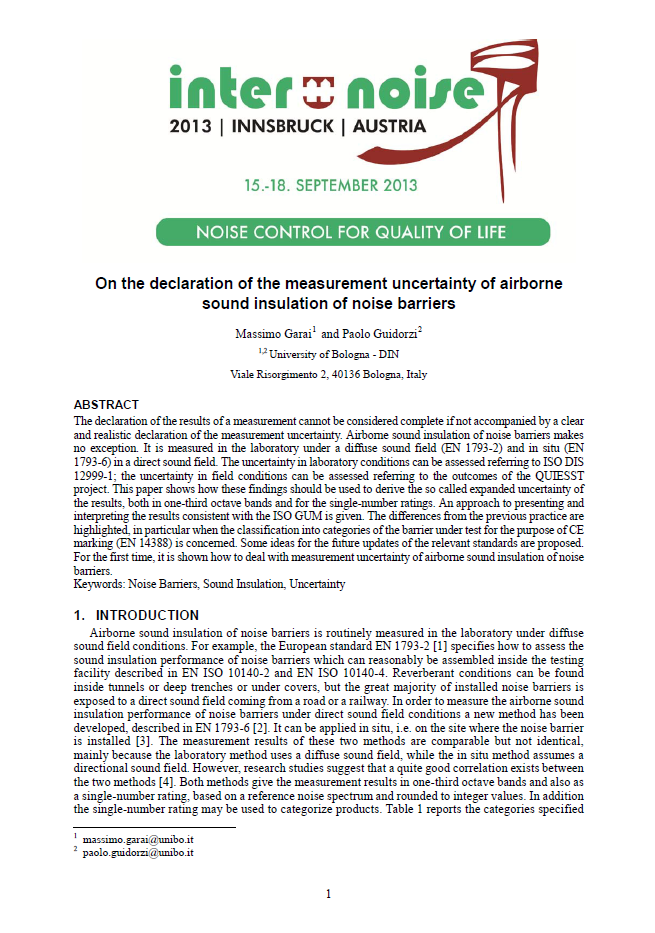
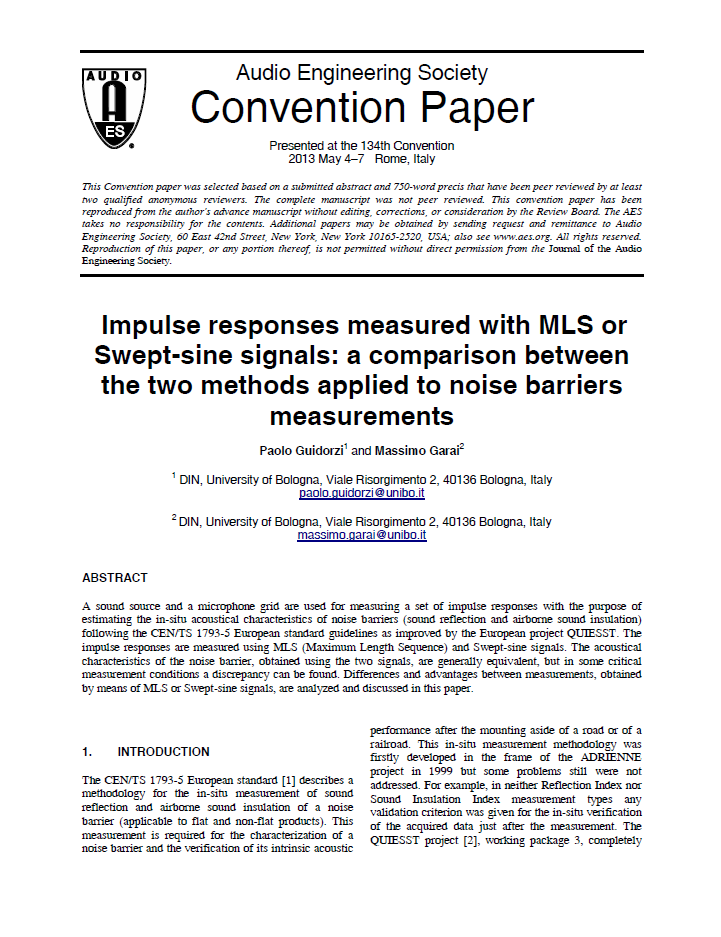

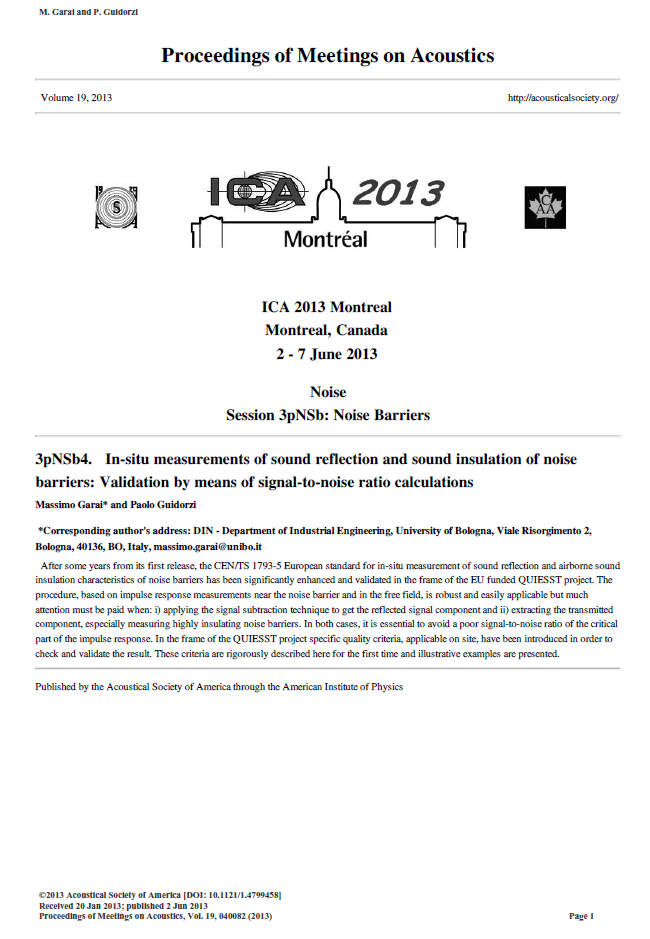
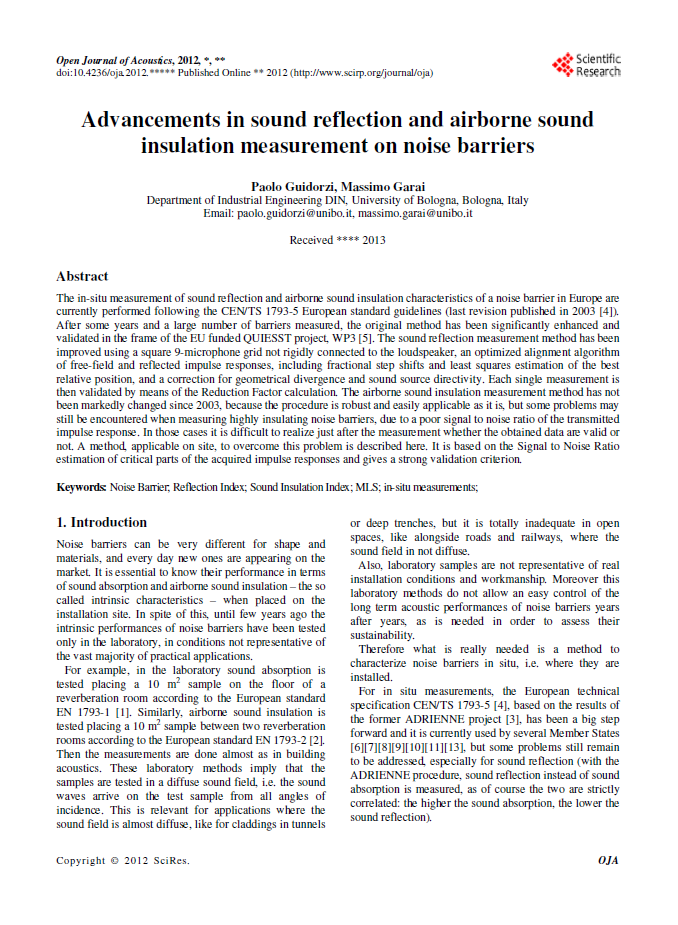
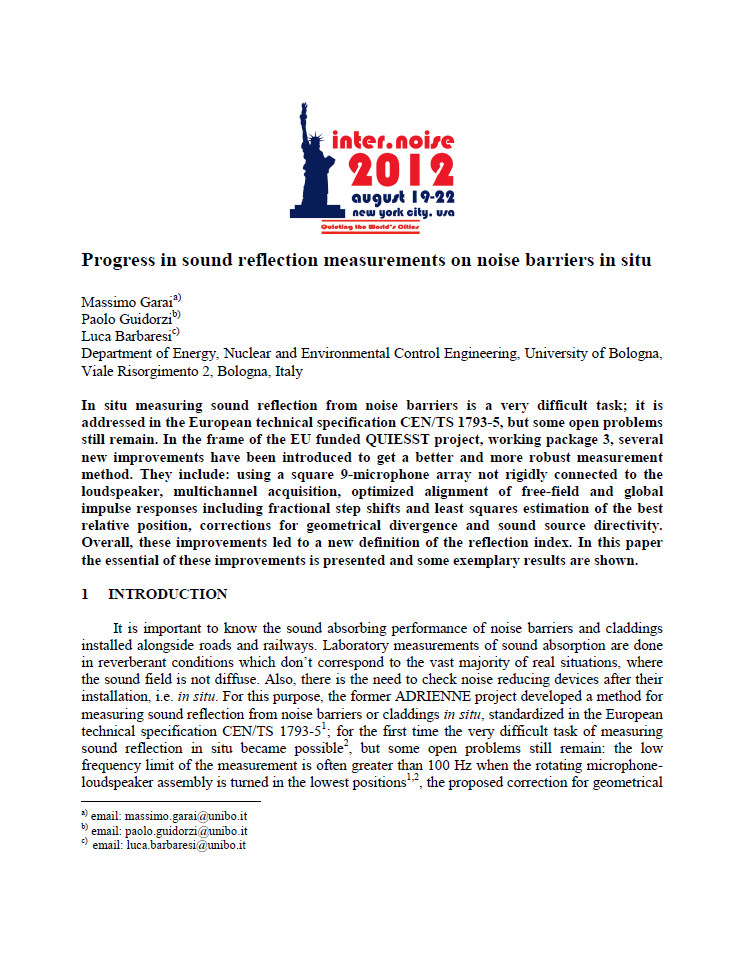
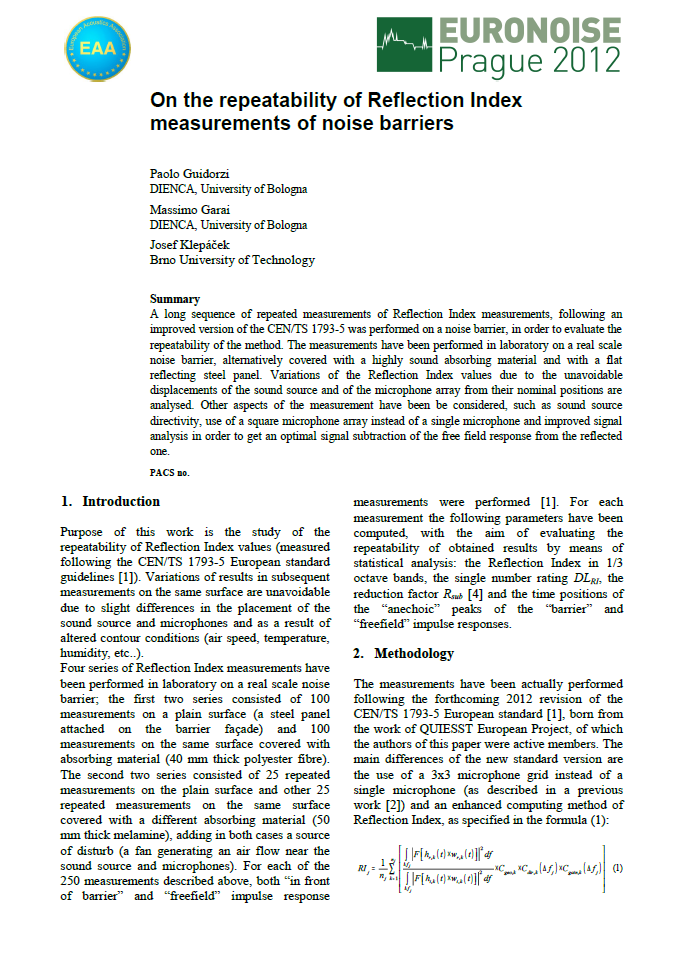
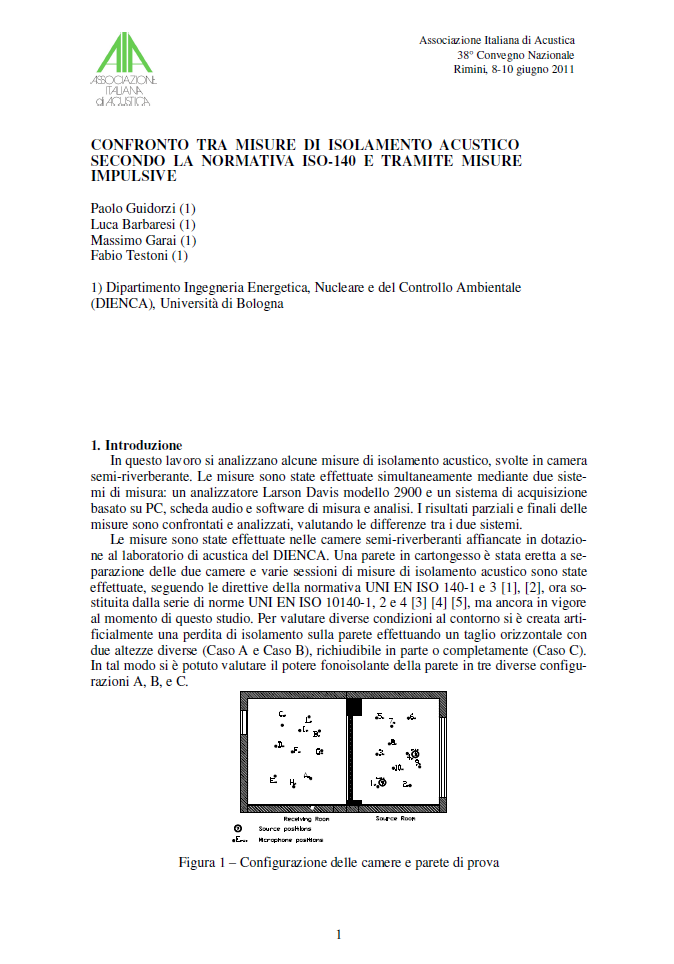

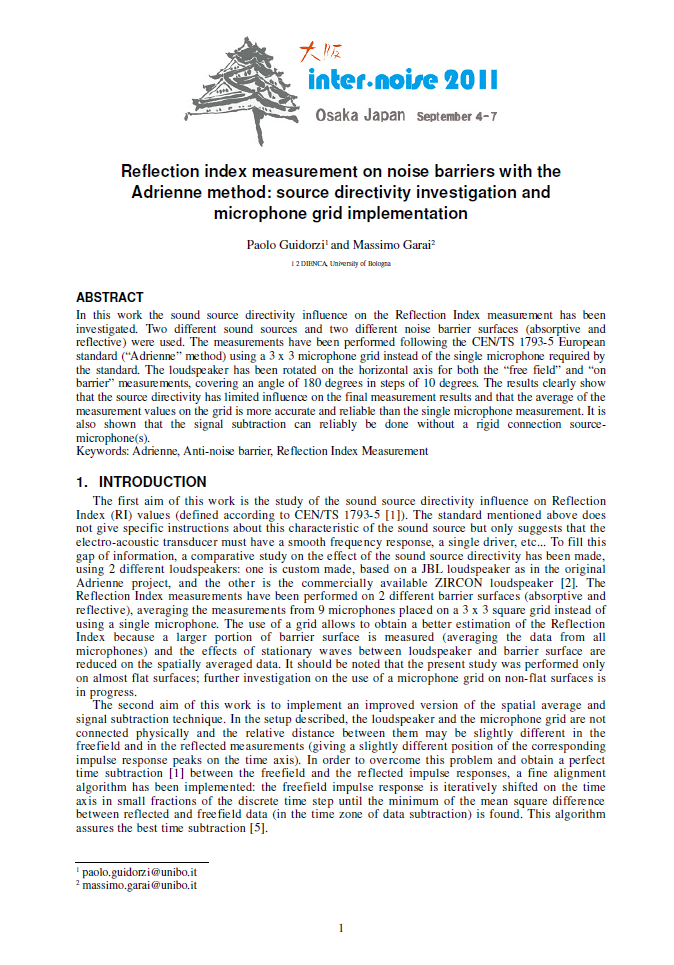

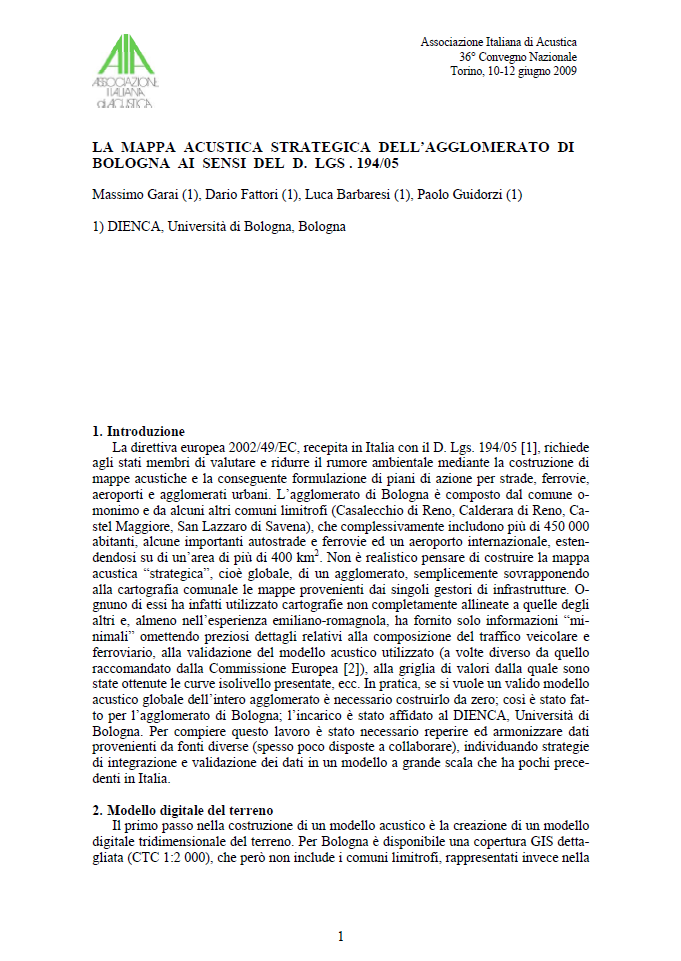
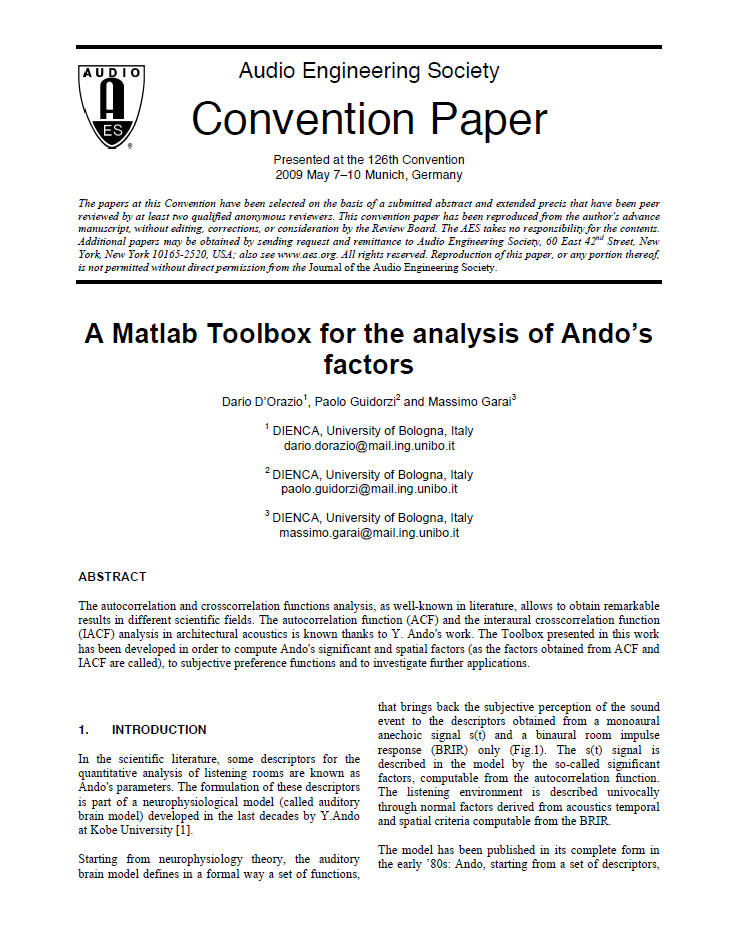
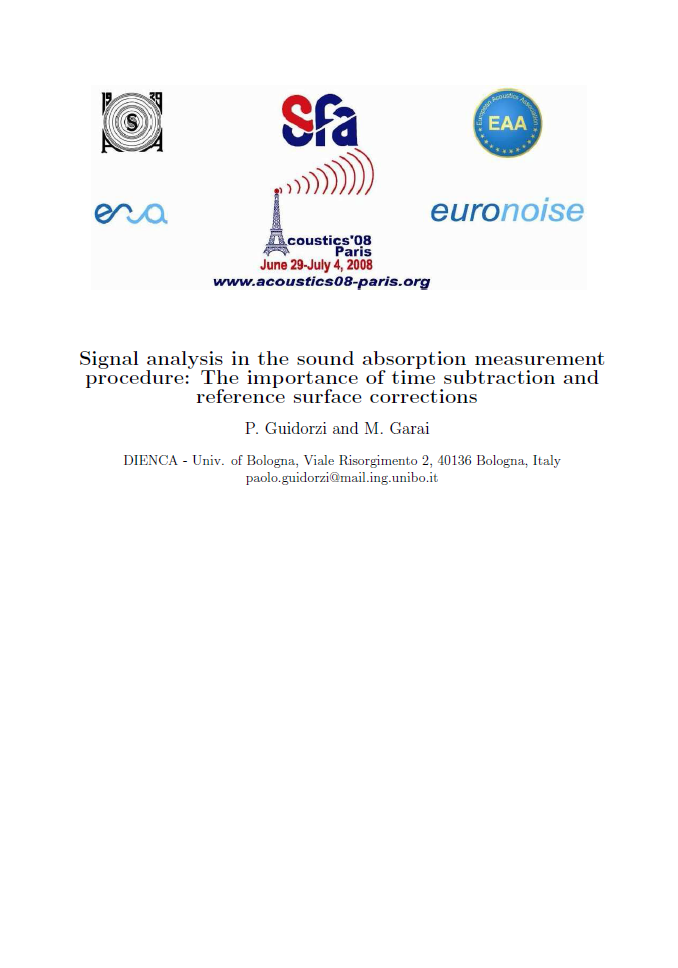
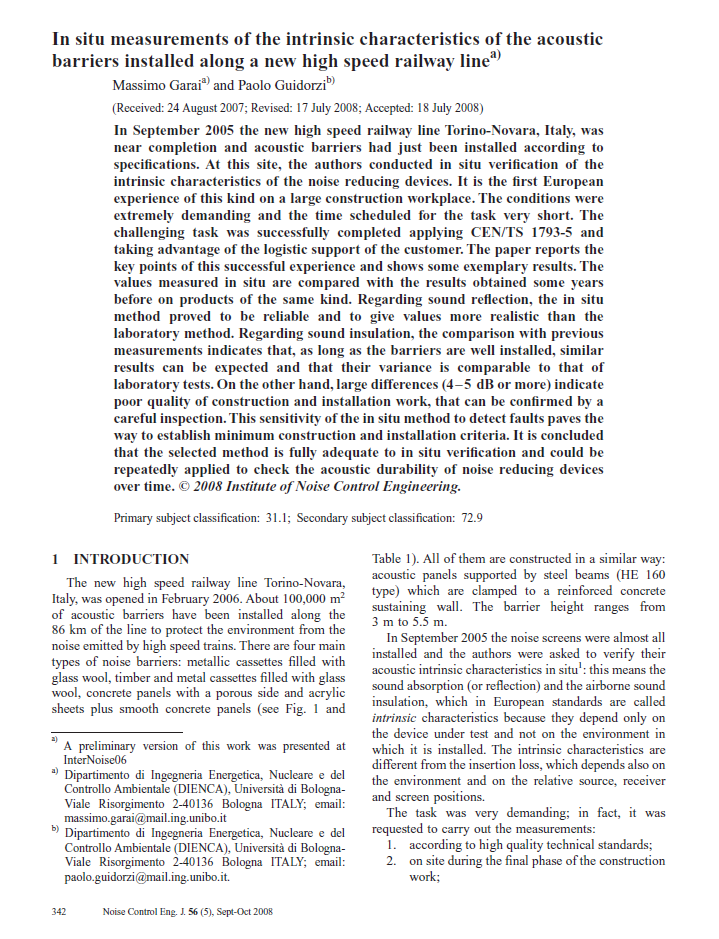
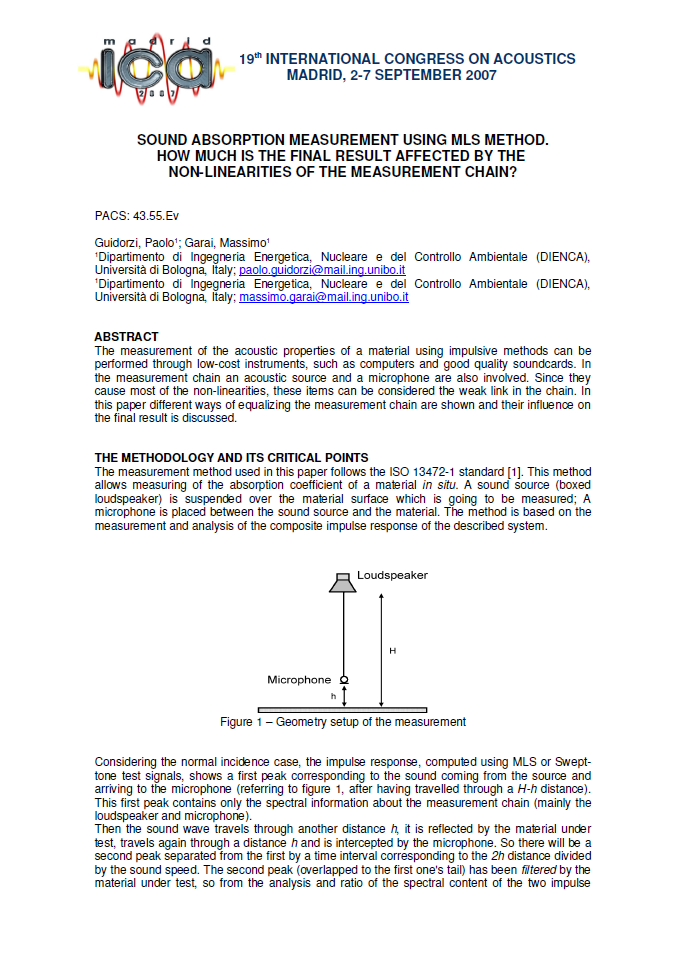
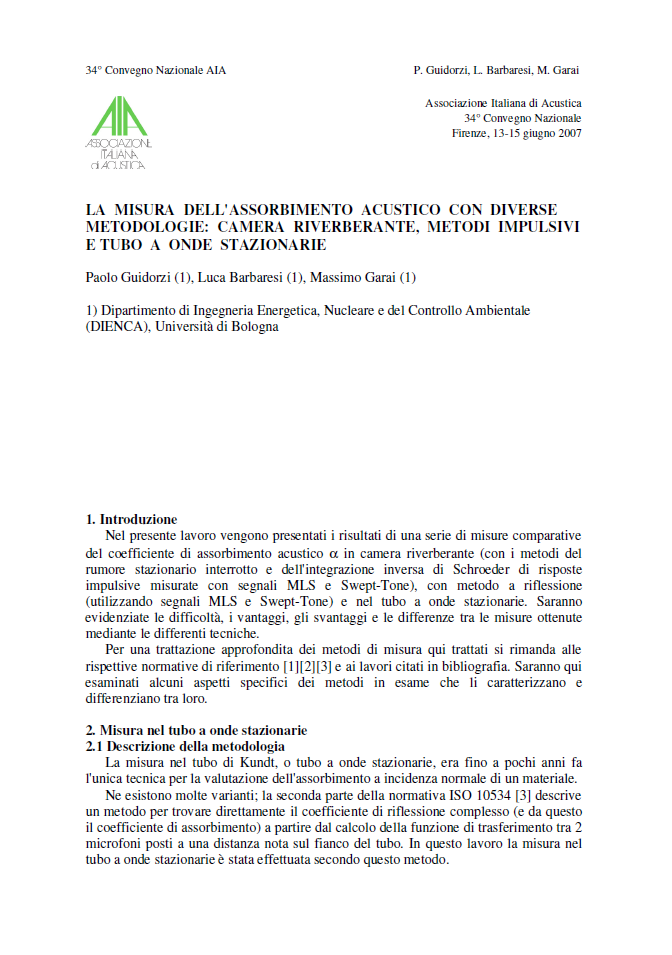

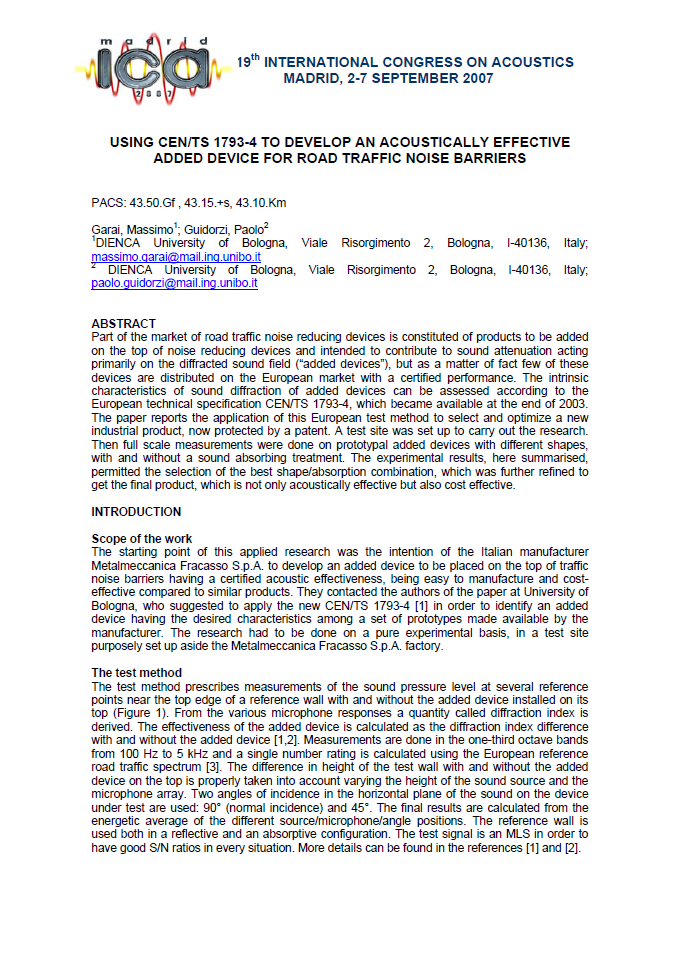








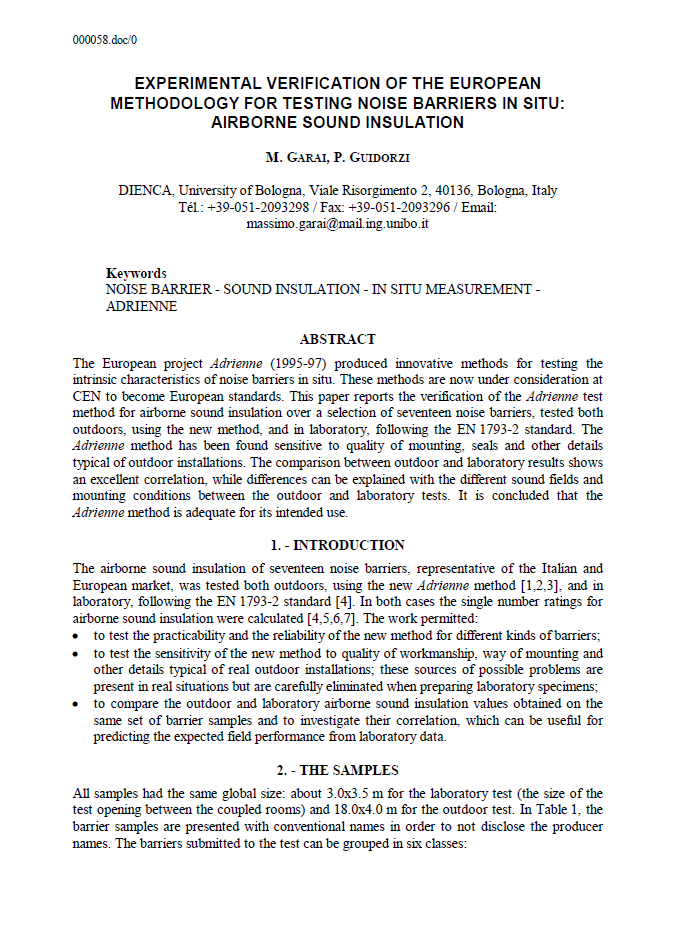
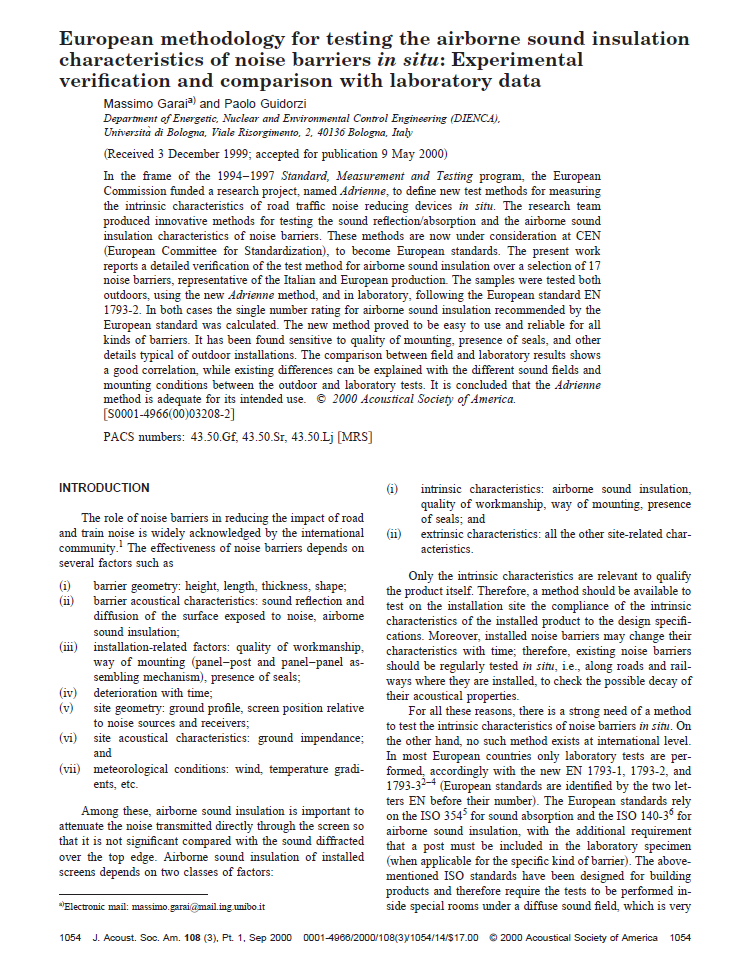
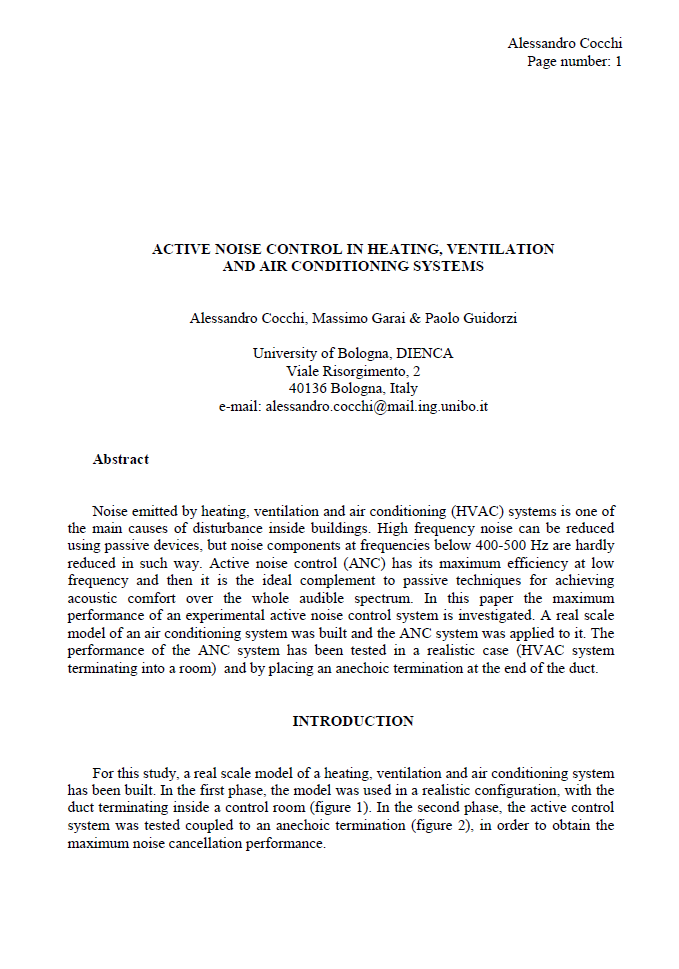
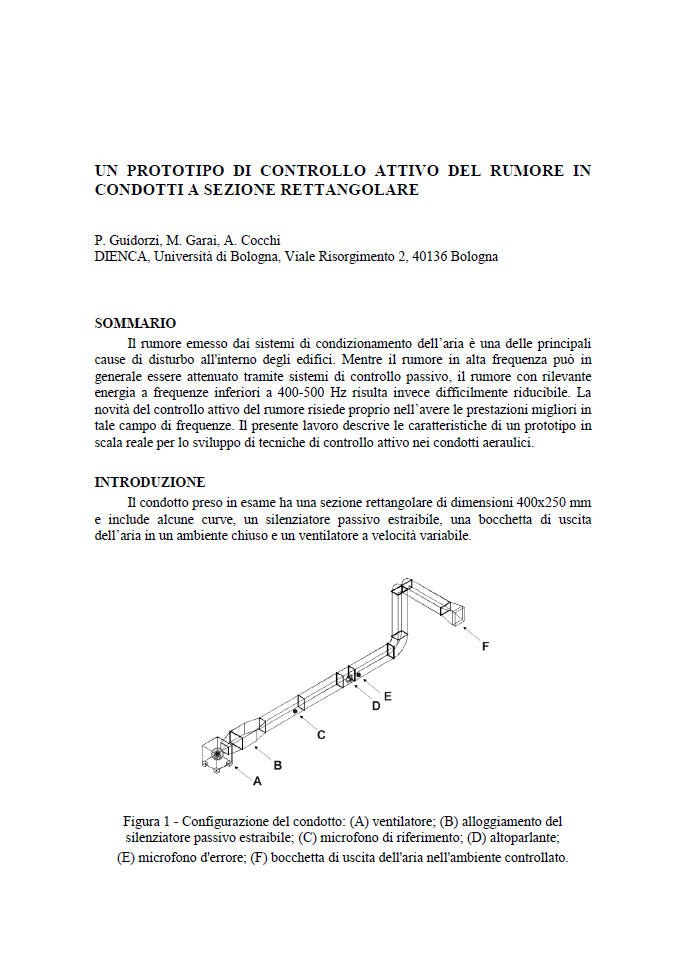
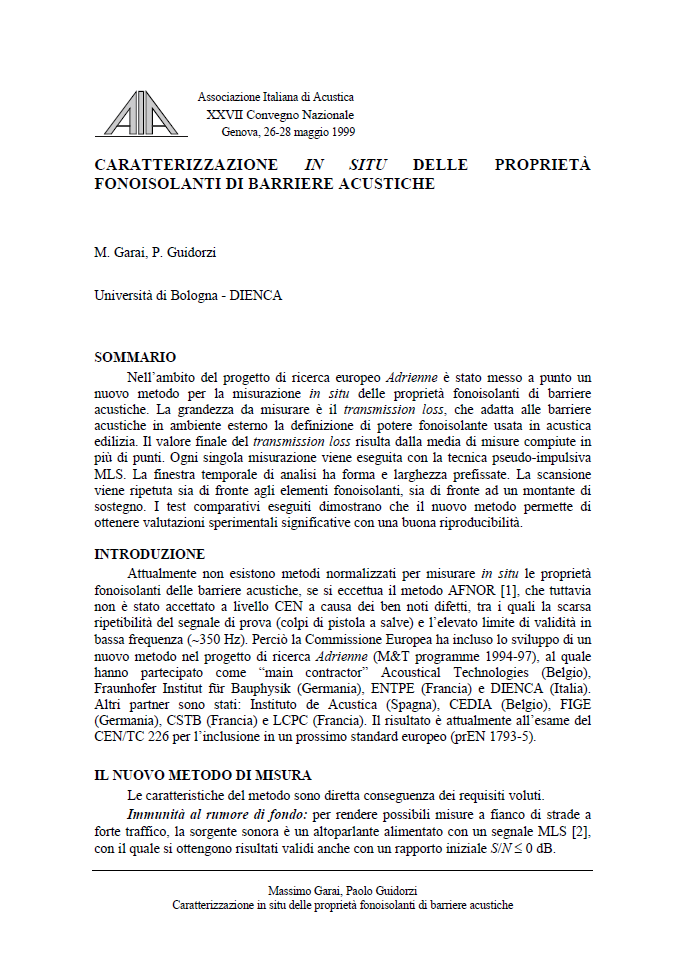
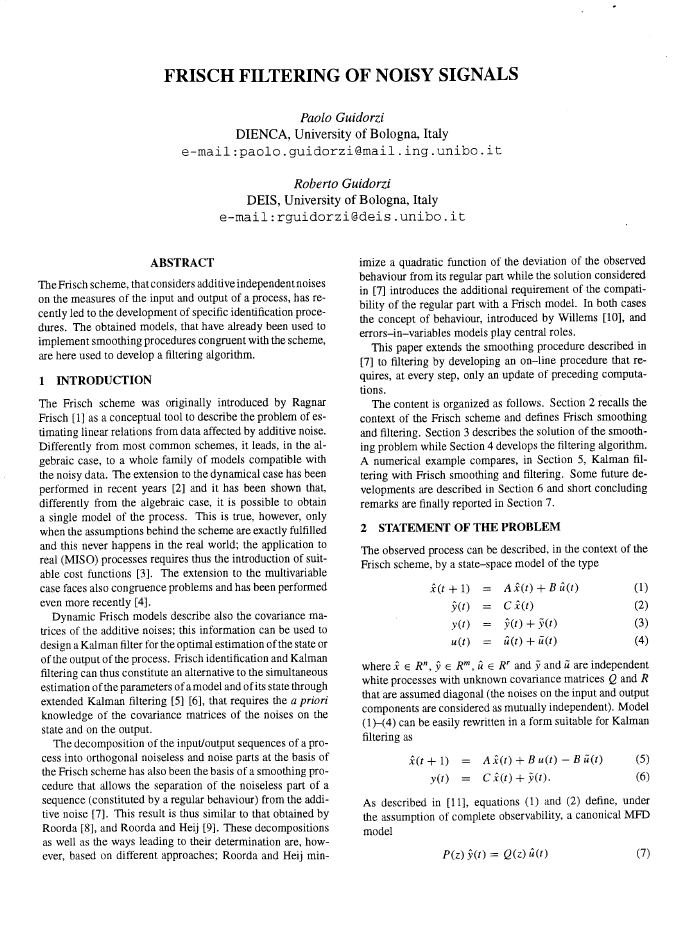
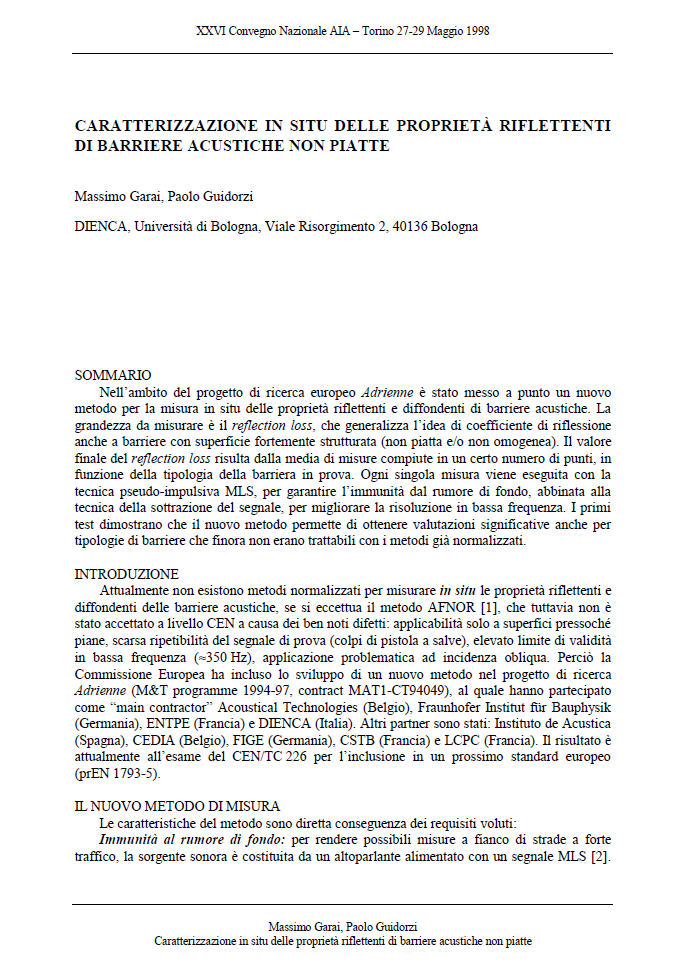


Questo sito non utilizza cookies. Componenti di terze parti potrebbero utilizzarli. Per maggiori informazioni clicca qui
Online Resources
Papers archive




































